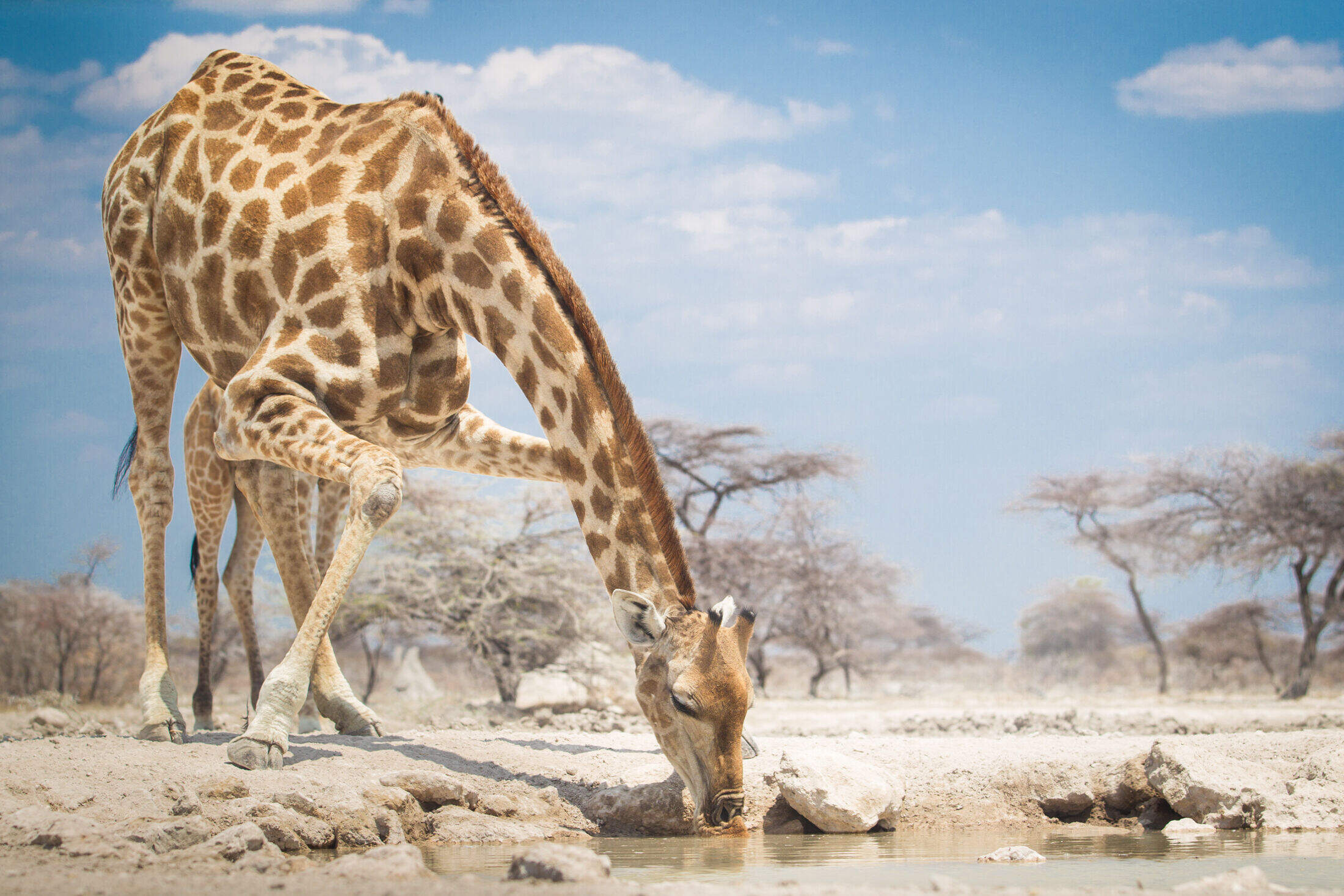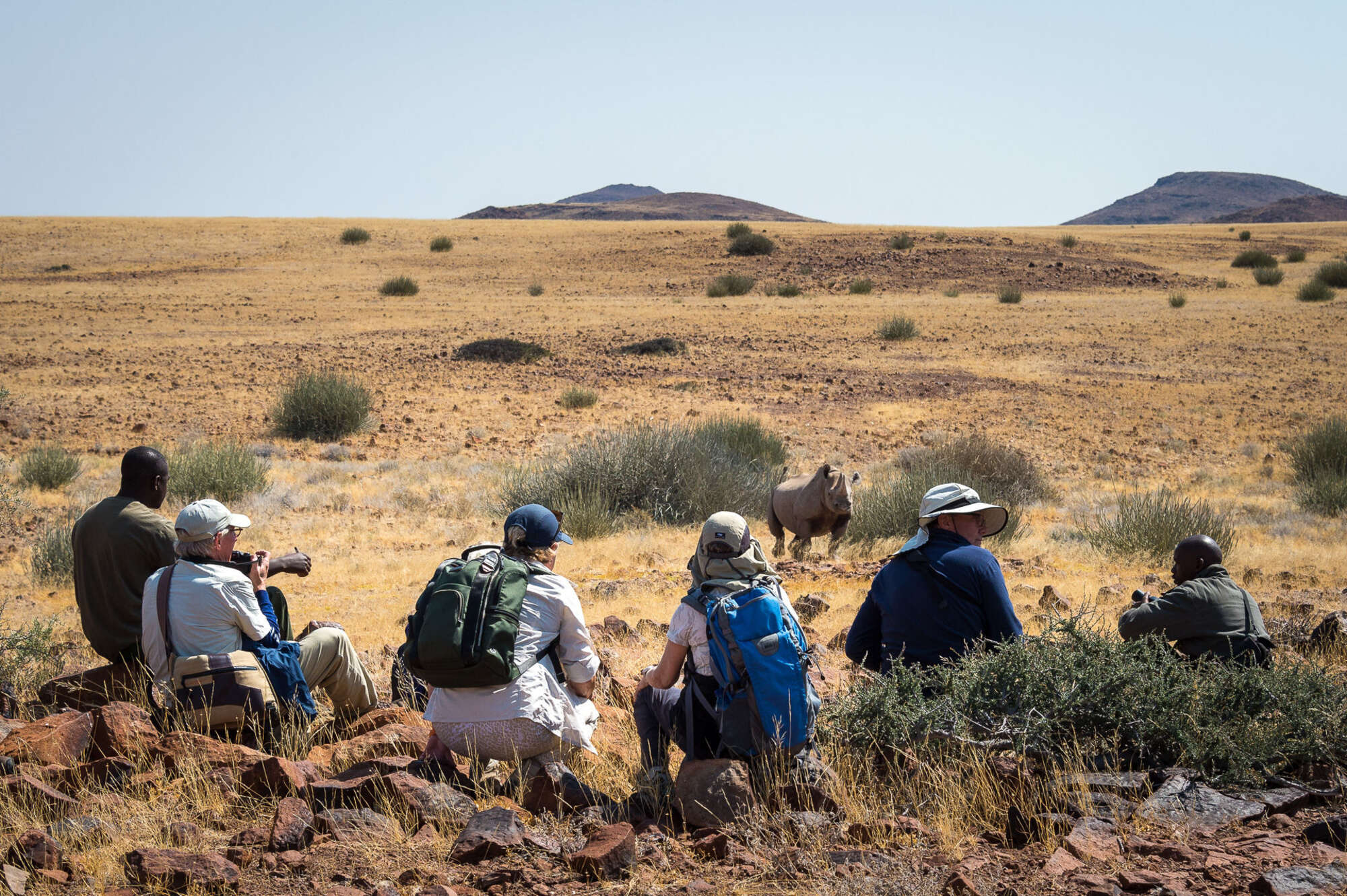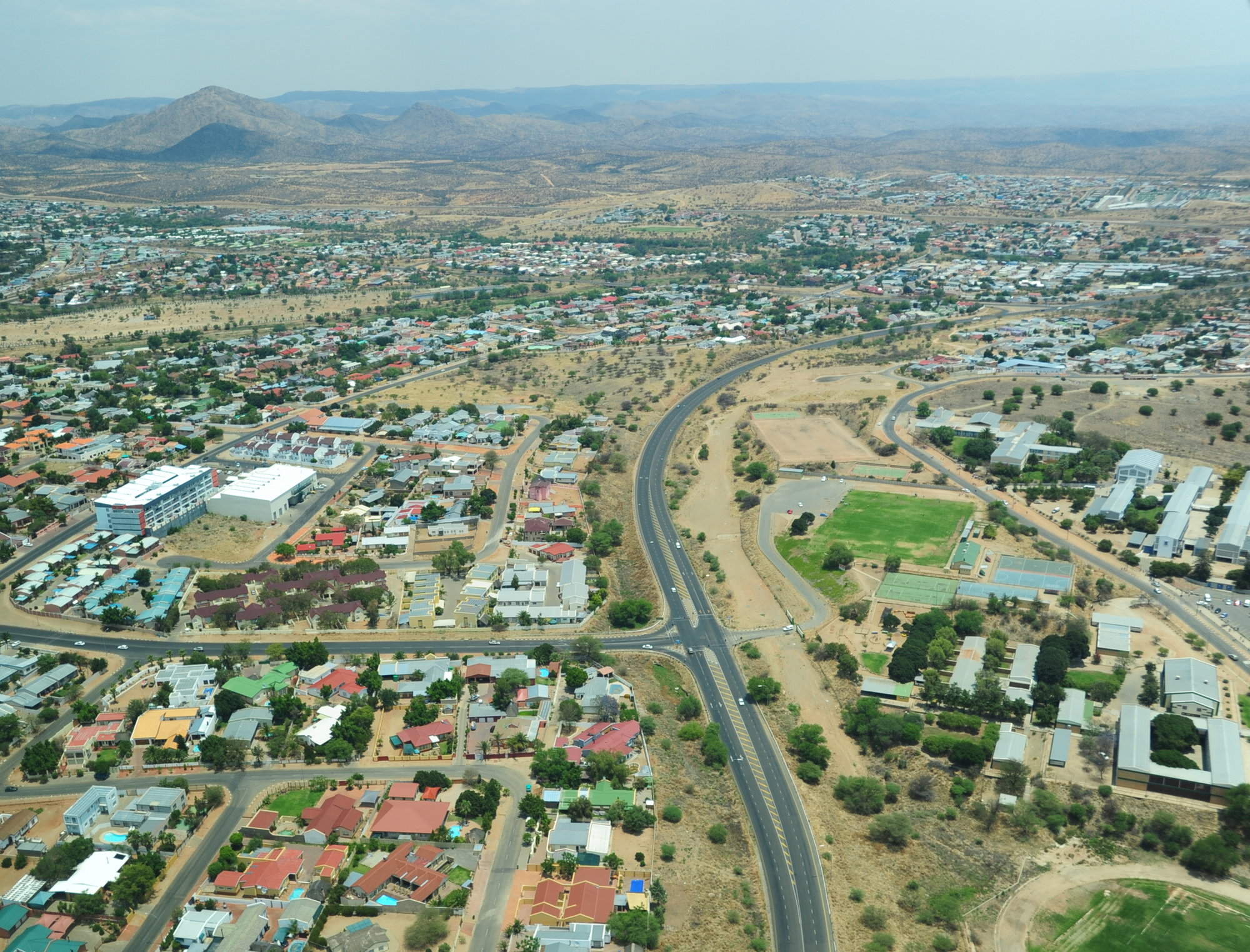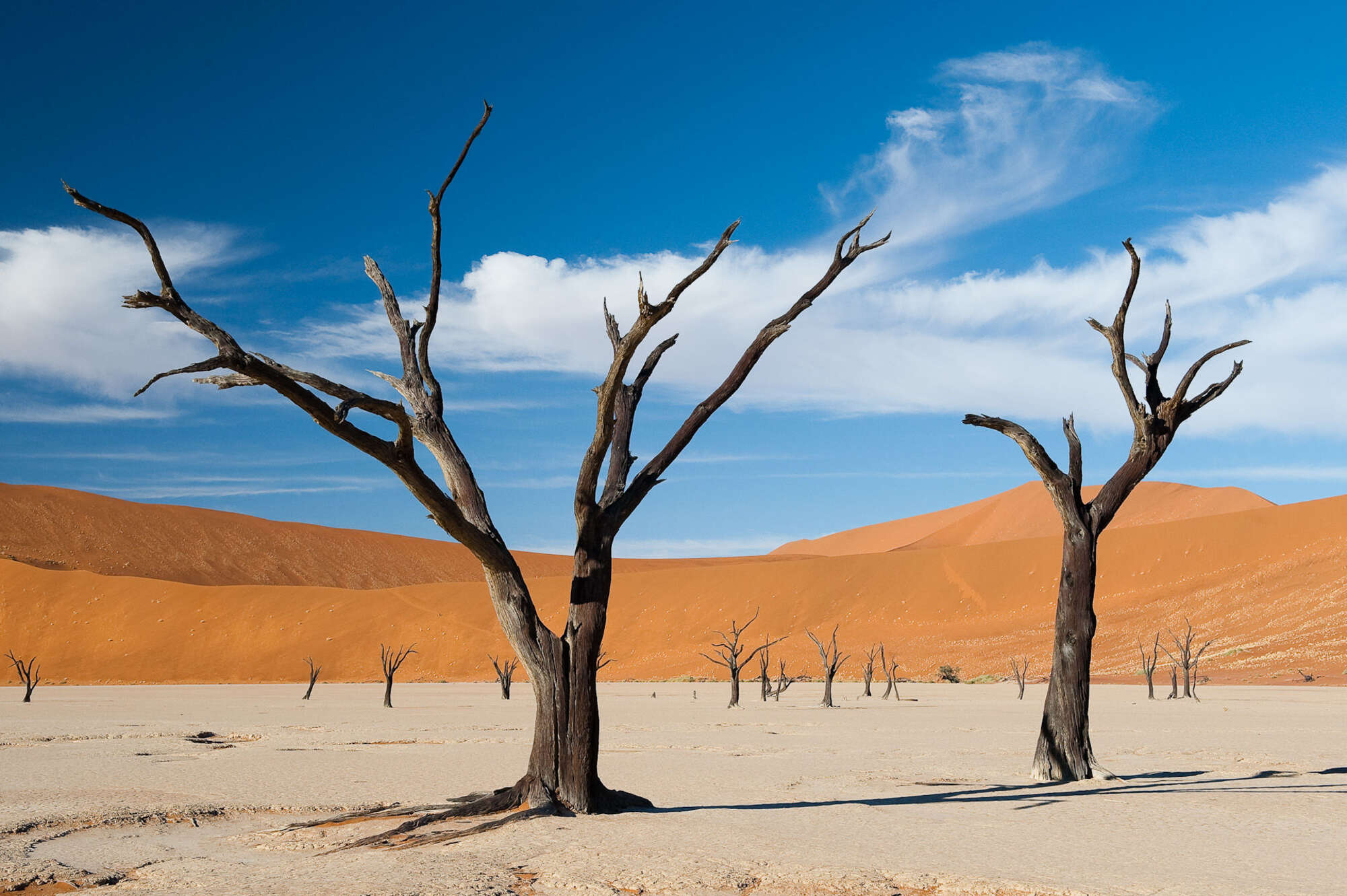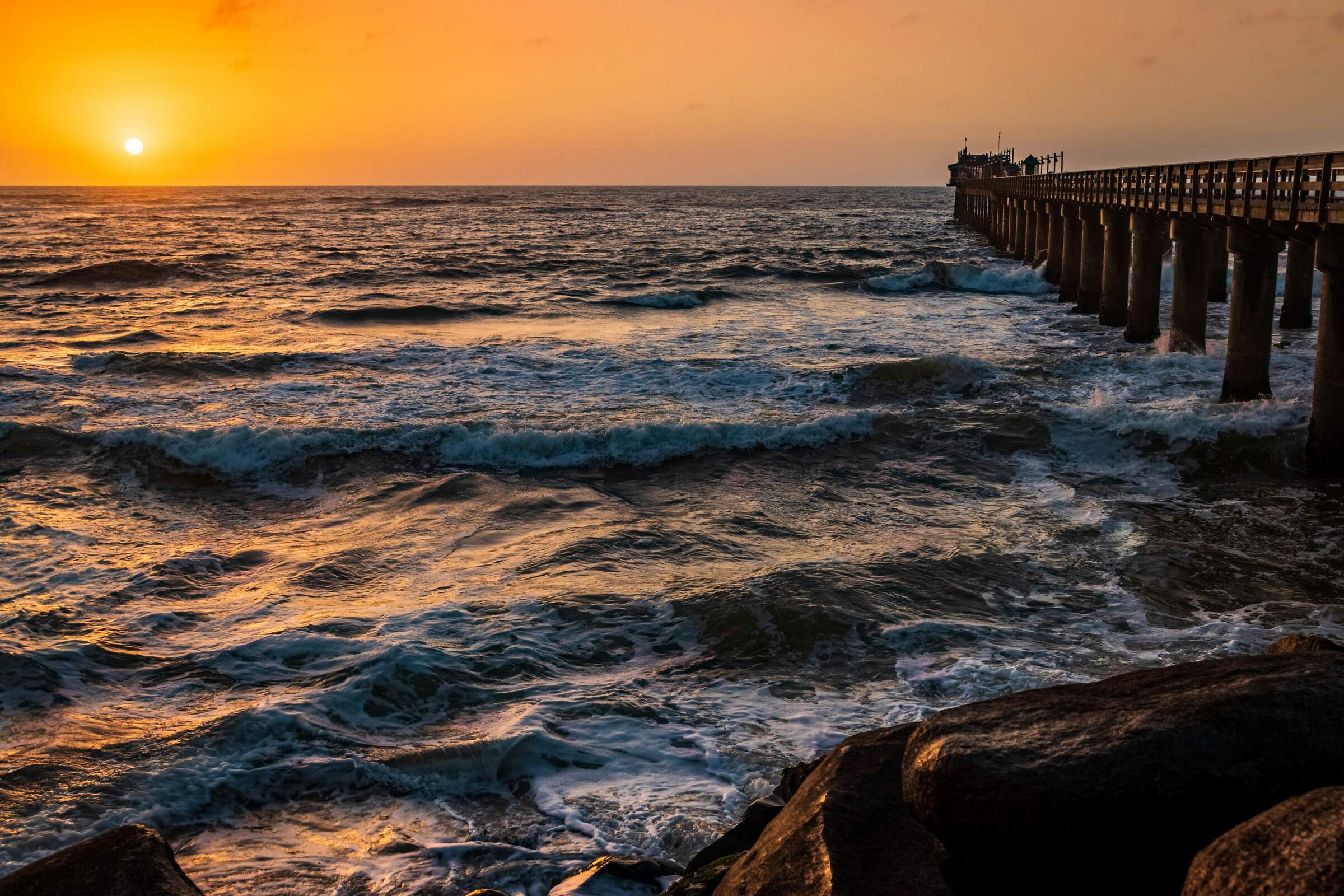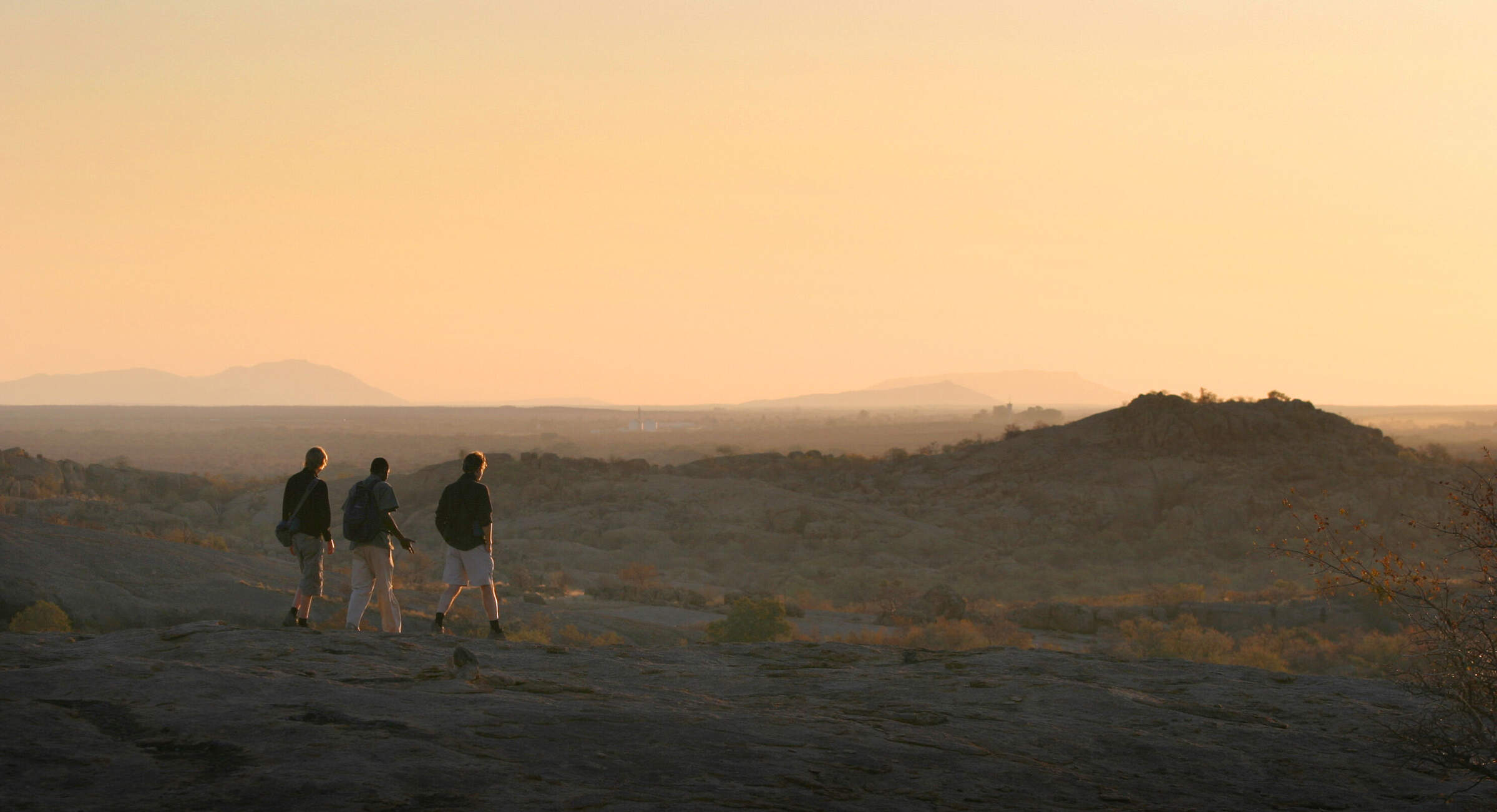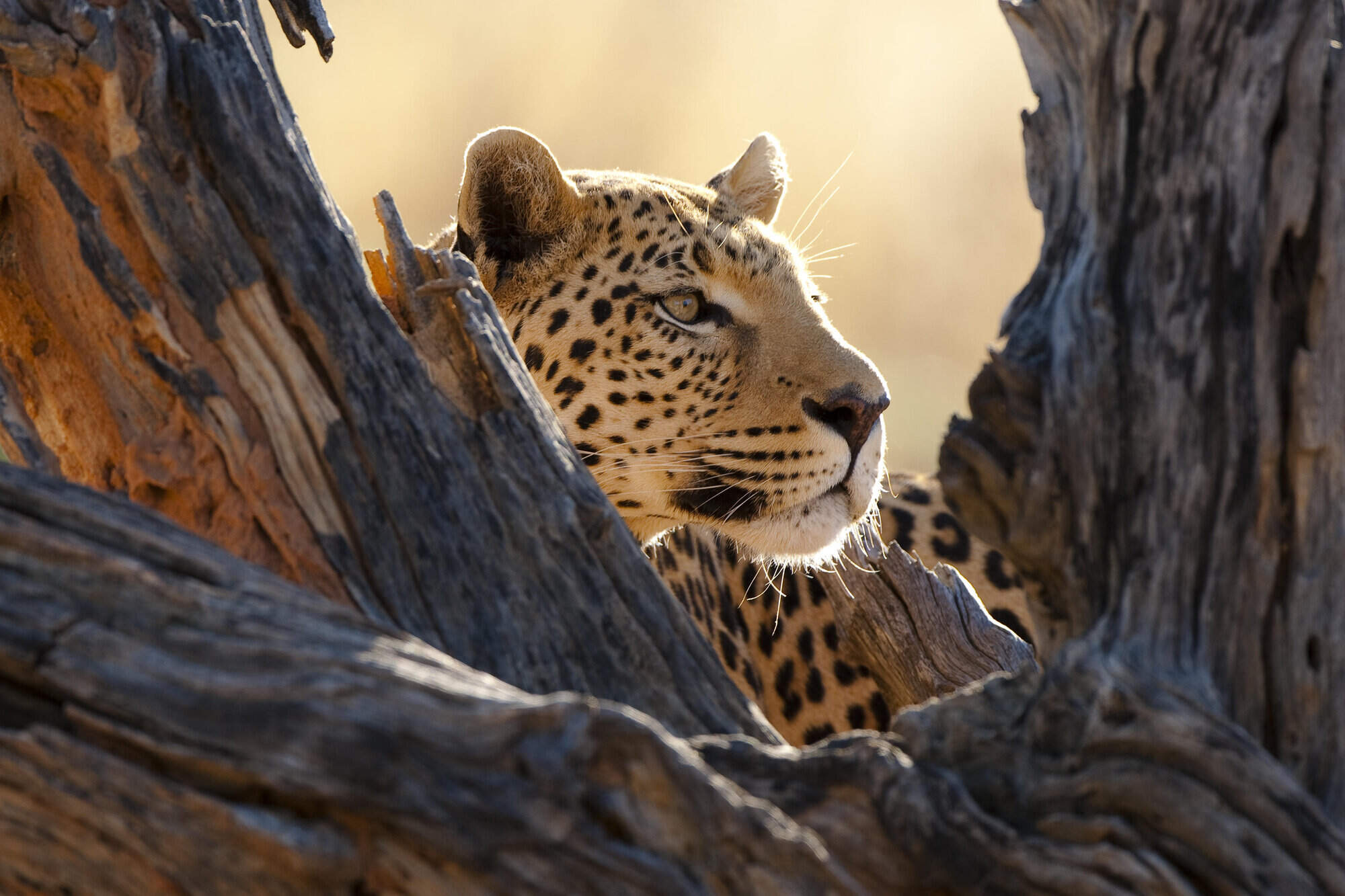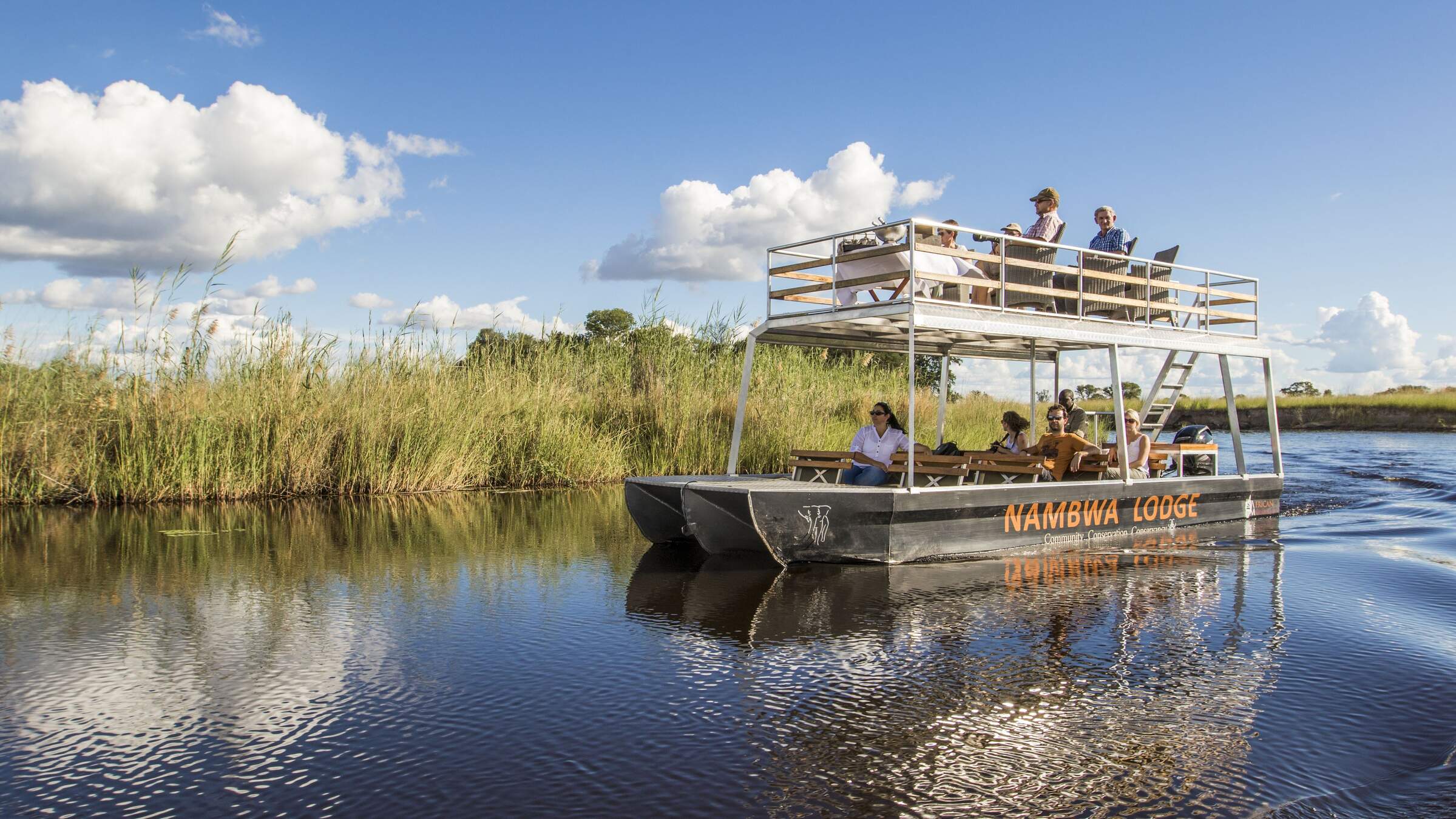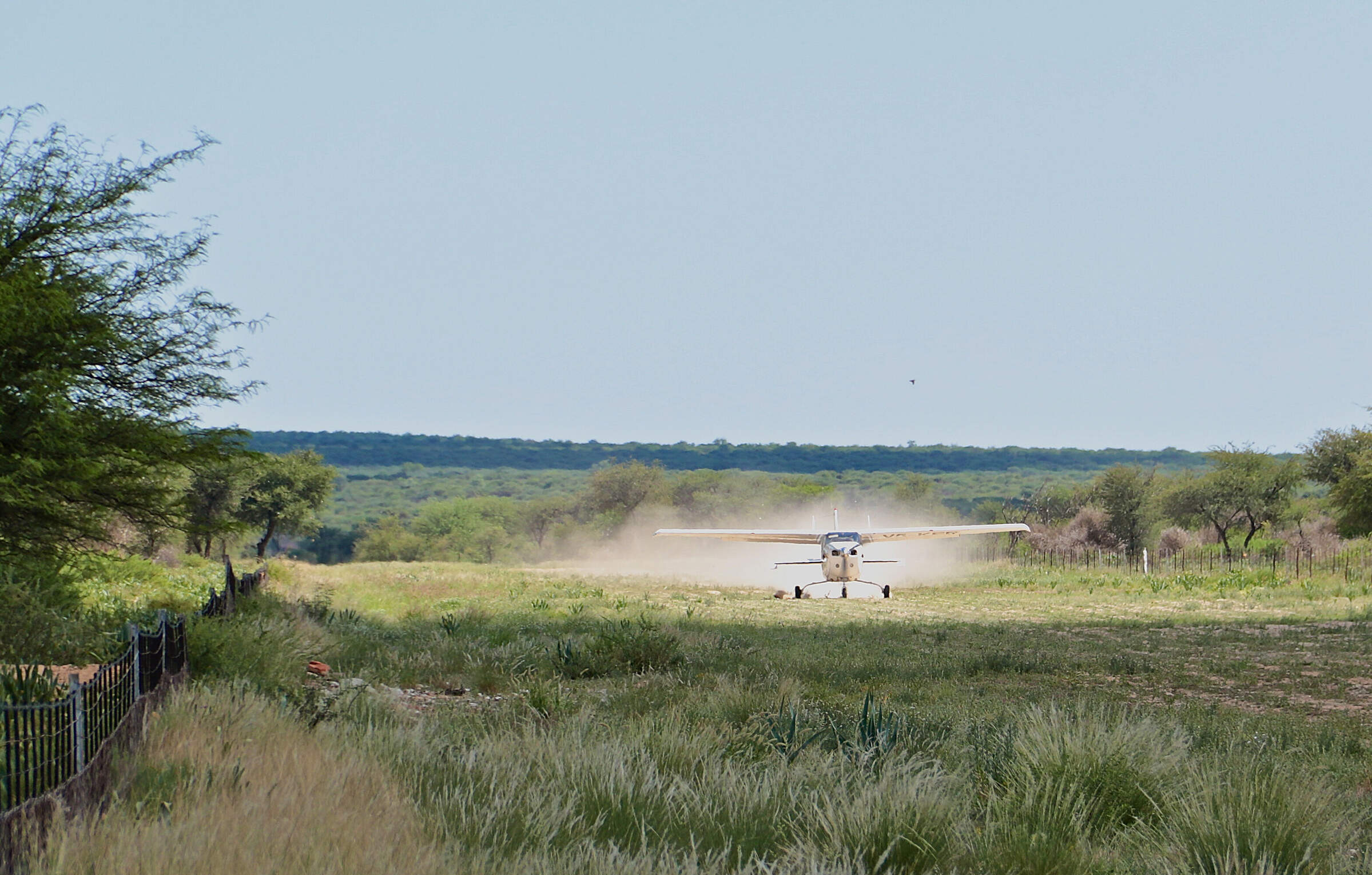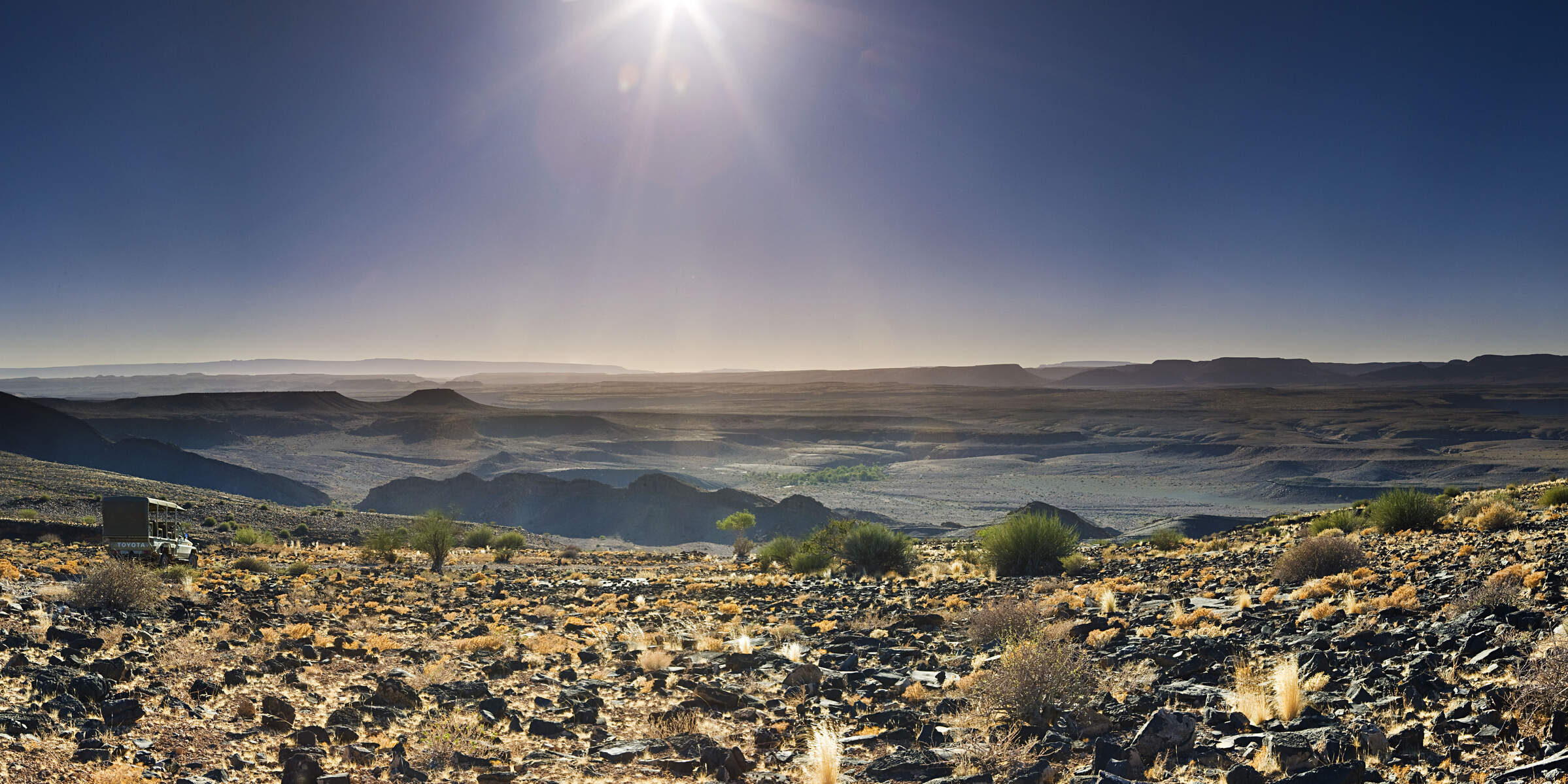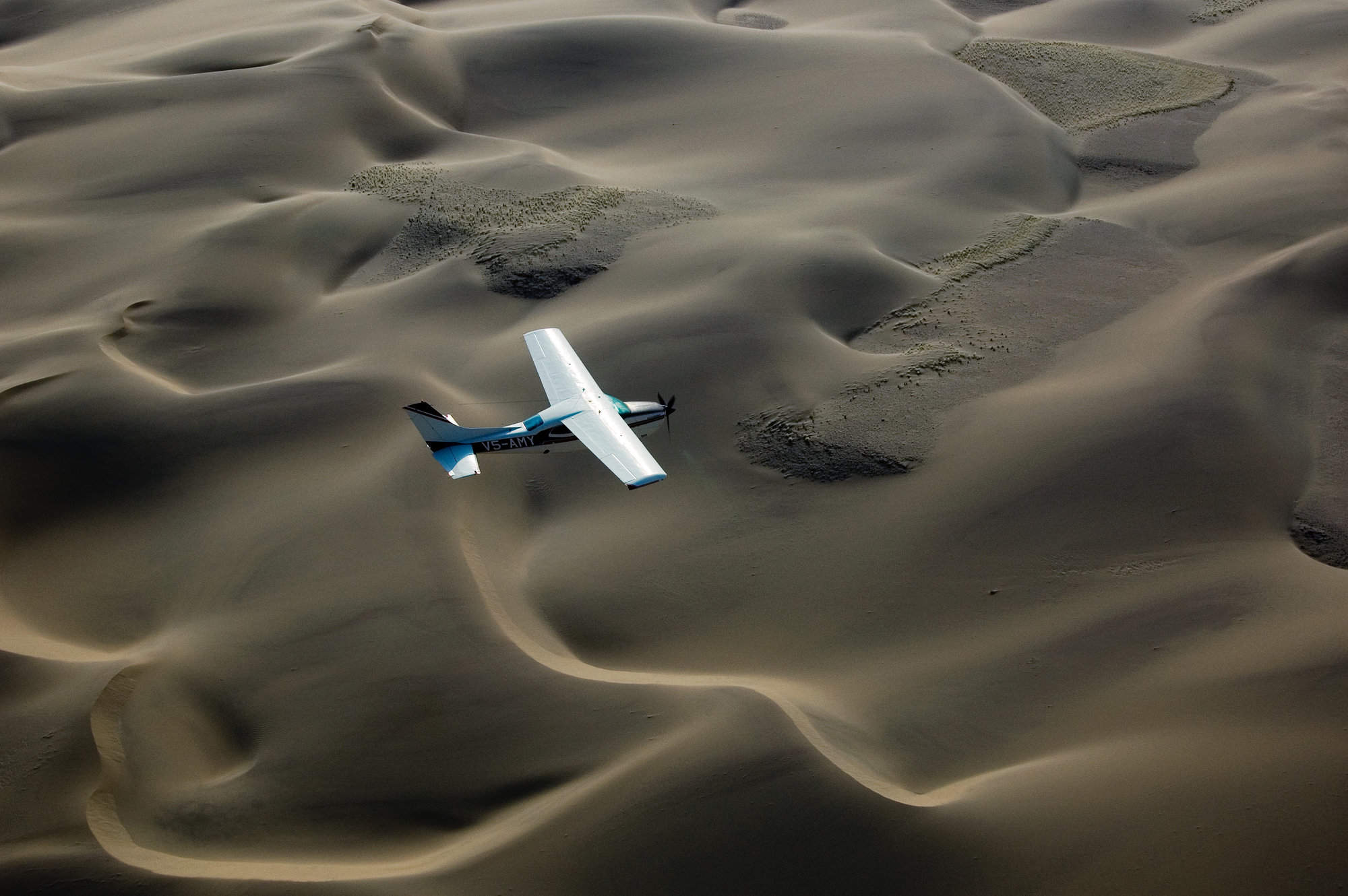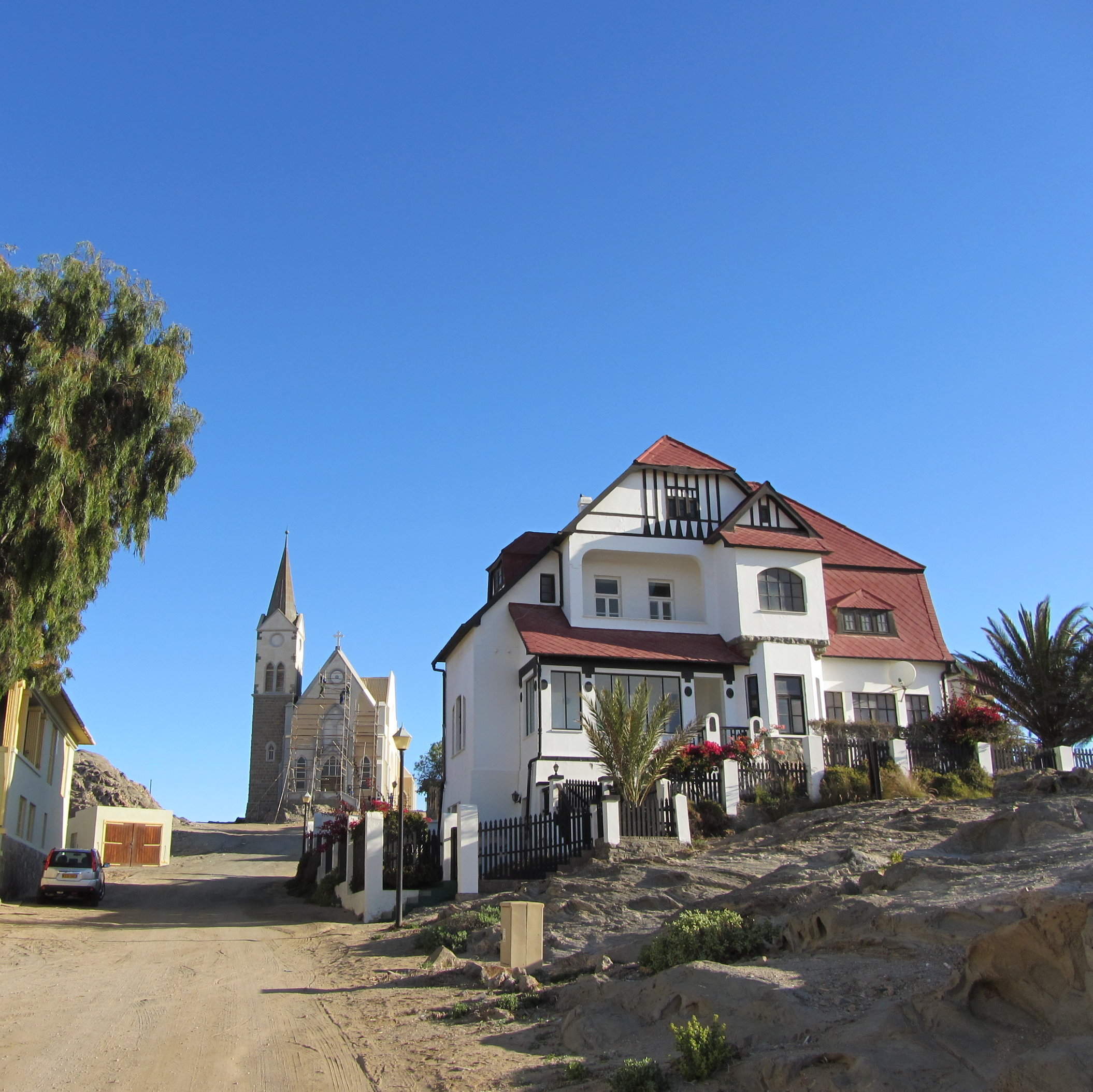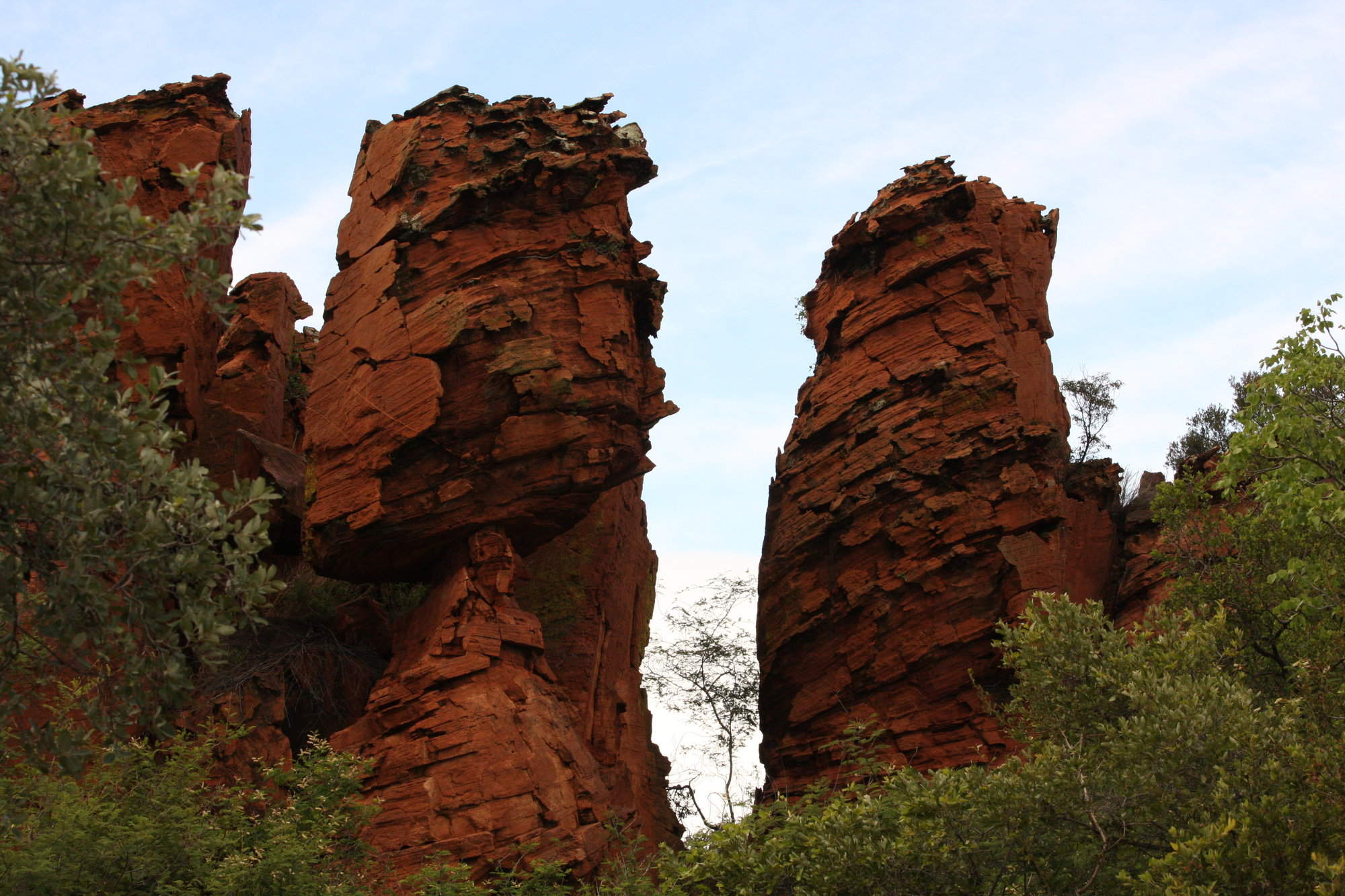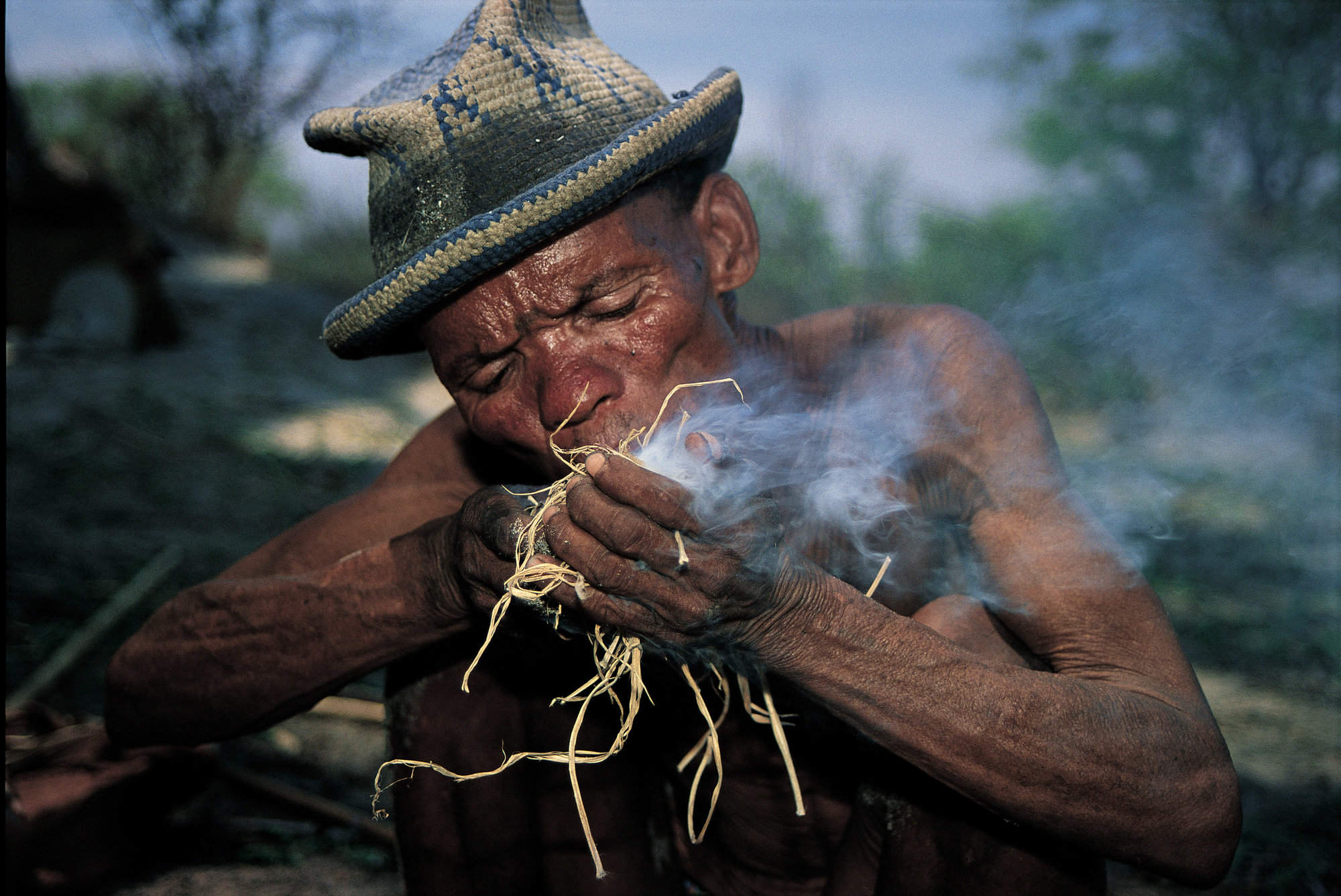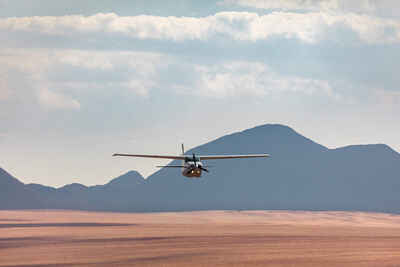
fly-ins are the ultimate way to experience Namibia
from vegetated dunes to fairy circles
...zebra...
weaver birds are nature's architects
golden grassy plains
tok-tokkie beetle is one of the desert adapted species.
dancing - shovel snounted lizard
the Namib Rand Reserve is made up of varying landscapes
from red sand dunes, to gravel plains and mountains
be astonished at the empty vastness
take in the gorgeous views bathed in the soft afternoon light
NamibRand Nature Reserve
NamibRand Nature Reserve
As dawn breaks, low dunes emerge from the twilight of the NamibRand, taking on the softest of apricot hues.
Almost imperceptibly, the colours deepen, and a scattering of near-translucent green materialises like sprinkles on a cake, the whole backed by distant mountains. It’s an alluring image, enhanced from the comfort of a warm bed, perhaps with a wake-up cup of tea in hand.
For the animals of the Namib, those fresh green shoots of spring are a welcome relief from the harsh reality of the desert. While human visitors bask in the scenic beauty, the photographic opportunities, the sheer scale of the place, animals face a constant fight for survival.
Not for them the scattering of small, highly professional lodges, with top-class food and drinks never far away, nor the guided walking trails, picnic carefully tucked into your daypack, a three-course dinner under the stars at the end of each day.
For wildlife, this wilderness is stark. With a 100km border shared with the Namib-Naukluft National Park, the huge private NamibRand Nature Reserve also shares its two greatest challenges: extremes of temperature, and an almost constant lack of water.
The photogenic oryx that poses for your camera is specially adapted to withstand these extremes, as are the extraordinary sand lizards that seem to dance on the dunes, and the tok tokkie beetles that have developed an ingenious way of collecting moisture. Black-backed jackals patrol the gravel plains, while raptors with piercing eyes soar above the mountains: the search for food is relentless.
To spend time in the NamibRand is to revel in the beauty of nature, to marvel at even the smallest of creatures, to gain an understanding, however small, of the daily miracle that is survival in this grand yet hostile environment.
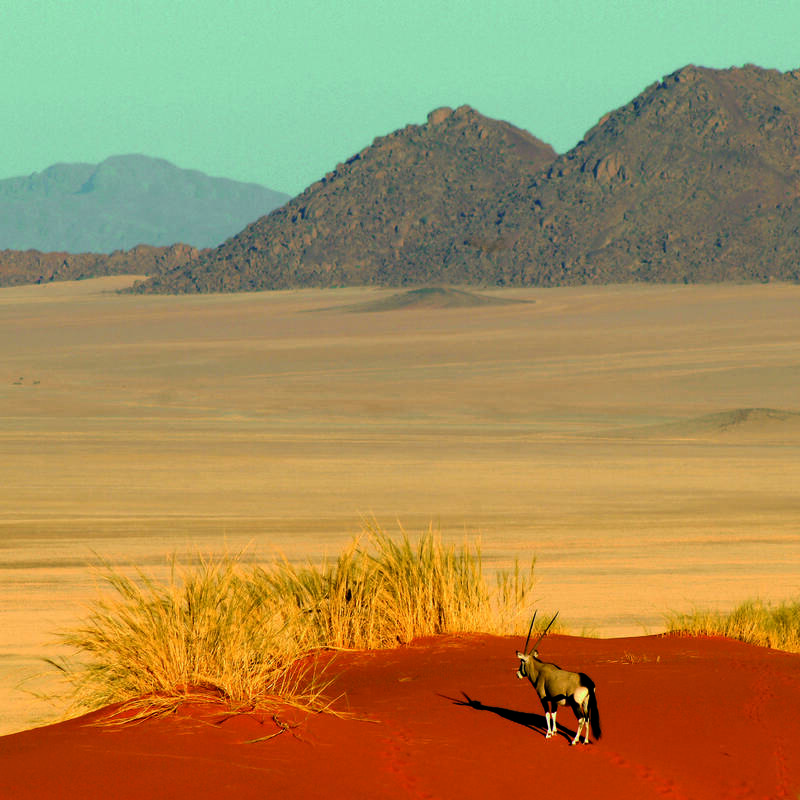
Trips including the NamibRand Nature Reserve
Just ideas, we'll always tailor-make a trip for you
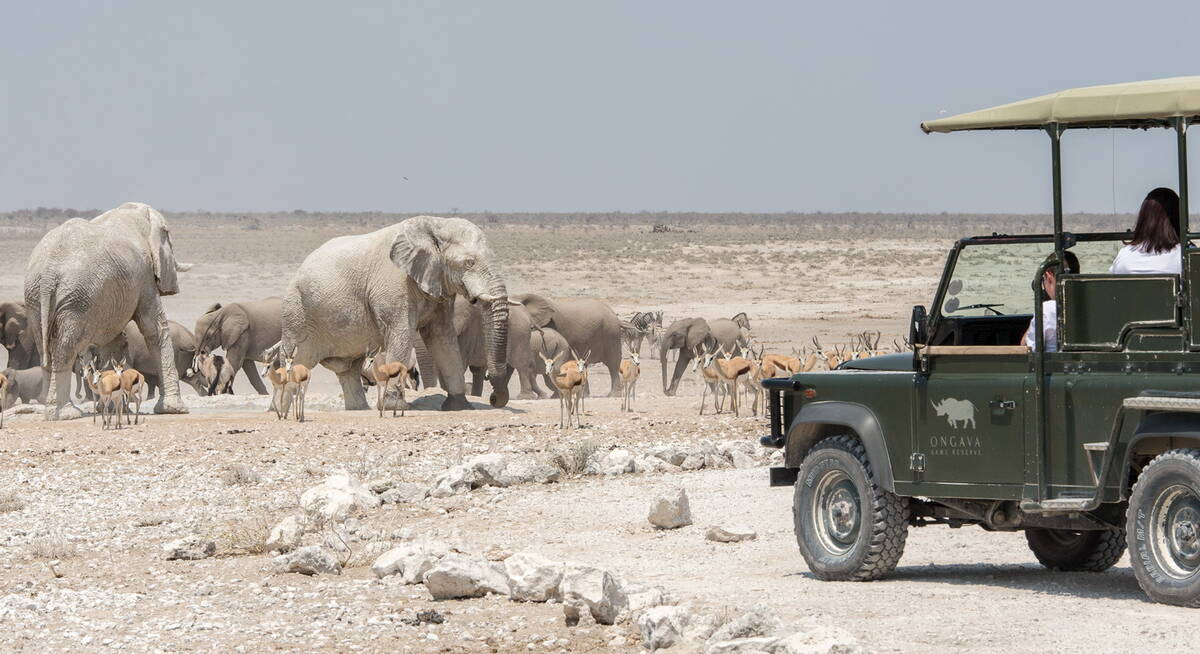
Brown Hyena Self-drive
14 days • 8 locations
WINDHOEK AIRPORT TO WINDHOEK AIRPORT
The perfect trip for those who want to mix the adventure and freedom of a self-drive with some of our favourite luxury camps in Namibia and a great mix of activities.
US$9,260 - US$10,210 per person
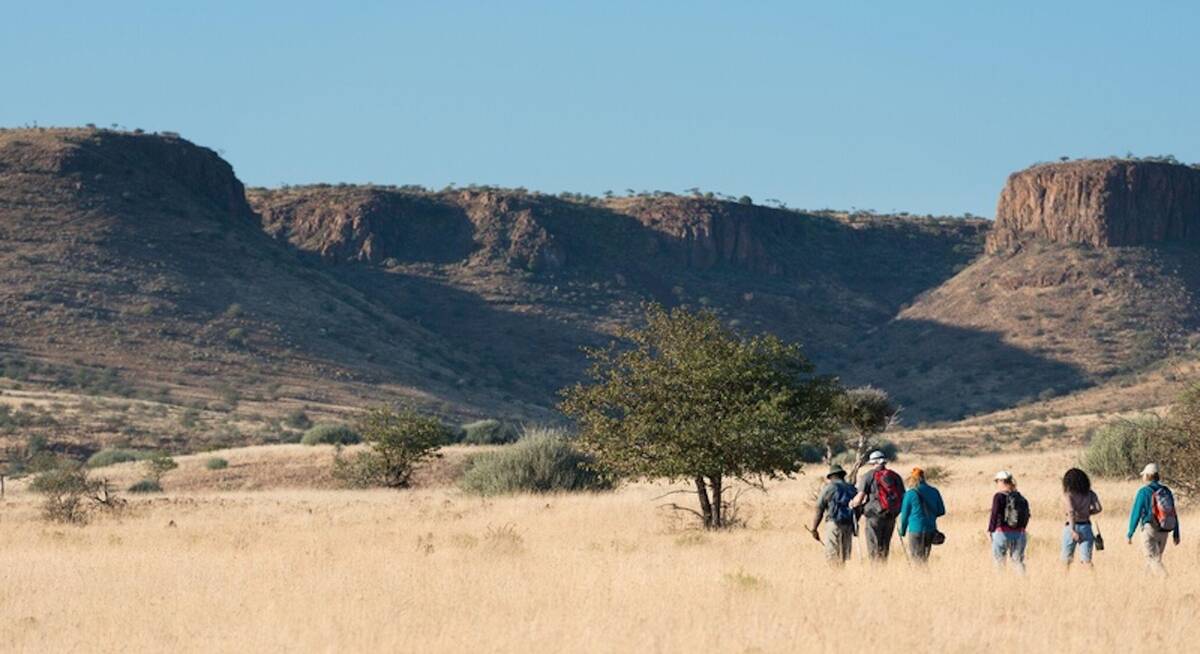
Chongololo Self-drive Safari
21 days • 11 locations
WINDHOEK AIRPORT TO WINDHOEK AIRPORT
This self-drive safari focuses on the best walking experiences in Namibia. Get your boots ready for the apricot dunes of the Namib Desert and the ancient hills of Damaraland.
US$9,260 - US$10,220 per person
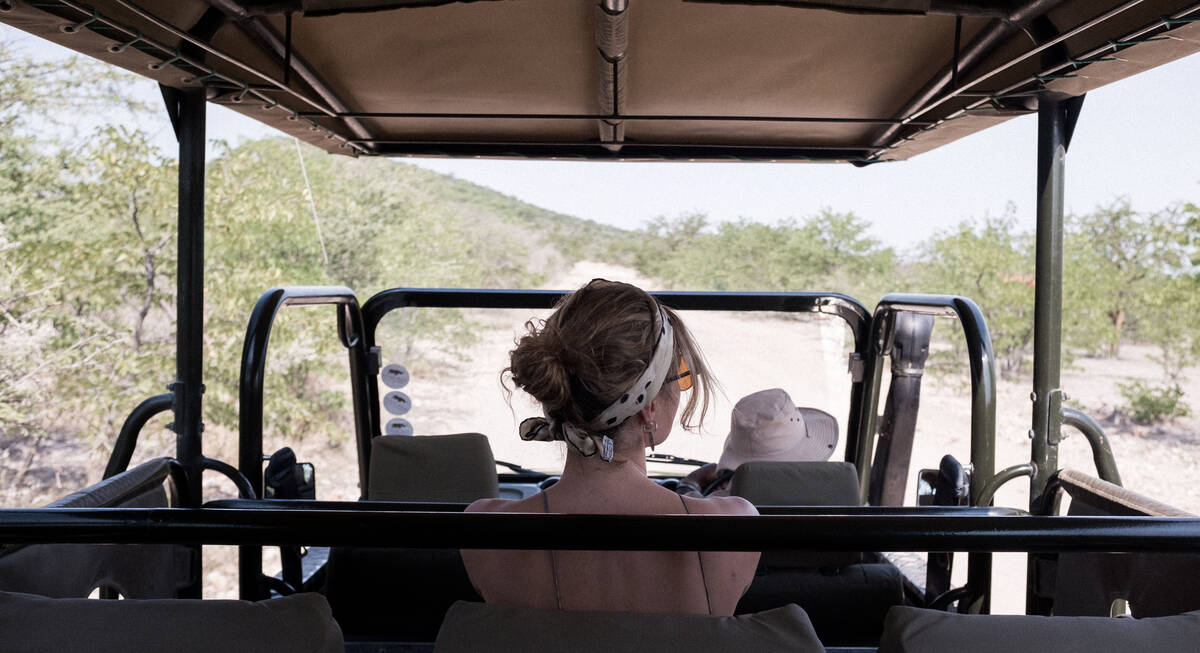
Rock Agama Self-drive Safari
9 days • 6 locations
WINDHOEK AIRPORT TO WINDHOEK AIRPORT
Big on experience and light on time, this self-drive trip packs in Namibia’s highlights while staying in a selection of luxury camps and lodges for an unforgettable 10 days.
US$9,920 - US$14,770 per person
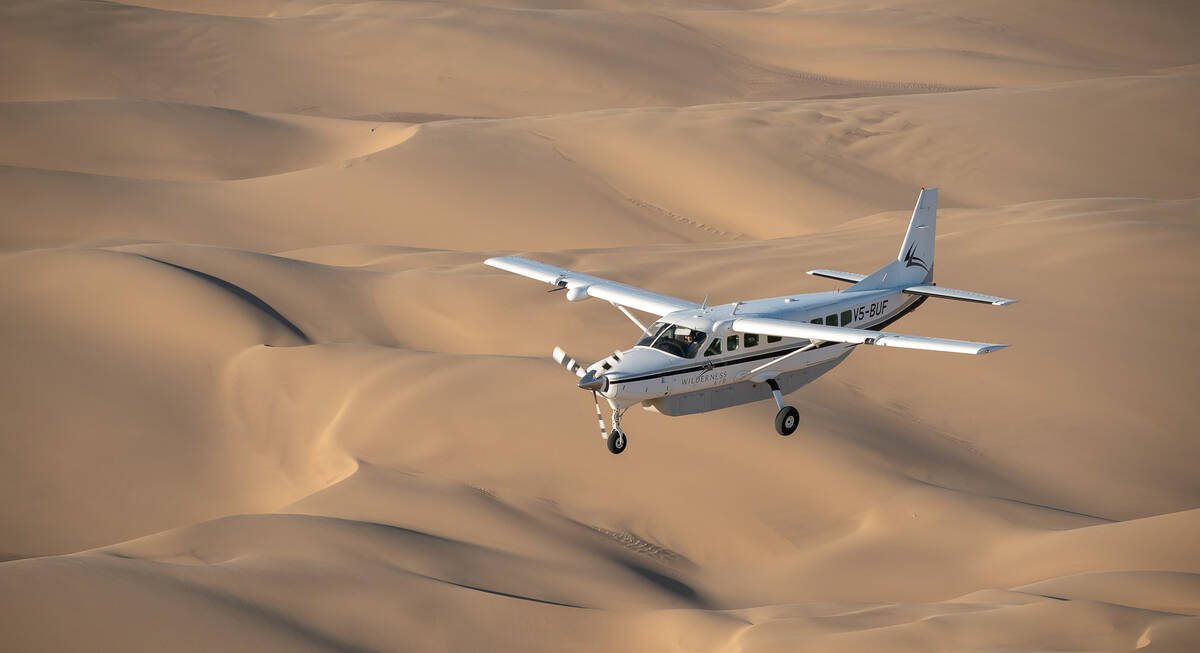
Goshawk Fly-in Safari
12 days • 6 locations
WINDHOEK AIRPORT TO WINDHOEK AIRPORT
Discover Namibia’s remarkable landscapes, fascinating wildlife and unique cultures on this luxury adventure flying between a selection of the very best camps and lodges in the country.
US$13,580 - US$20,350 per person
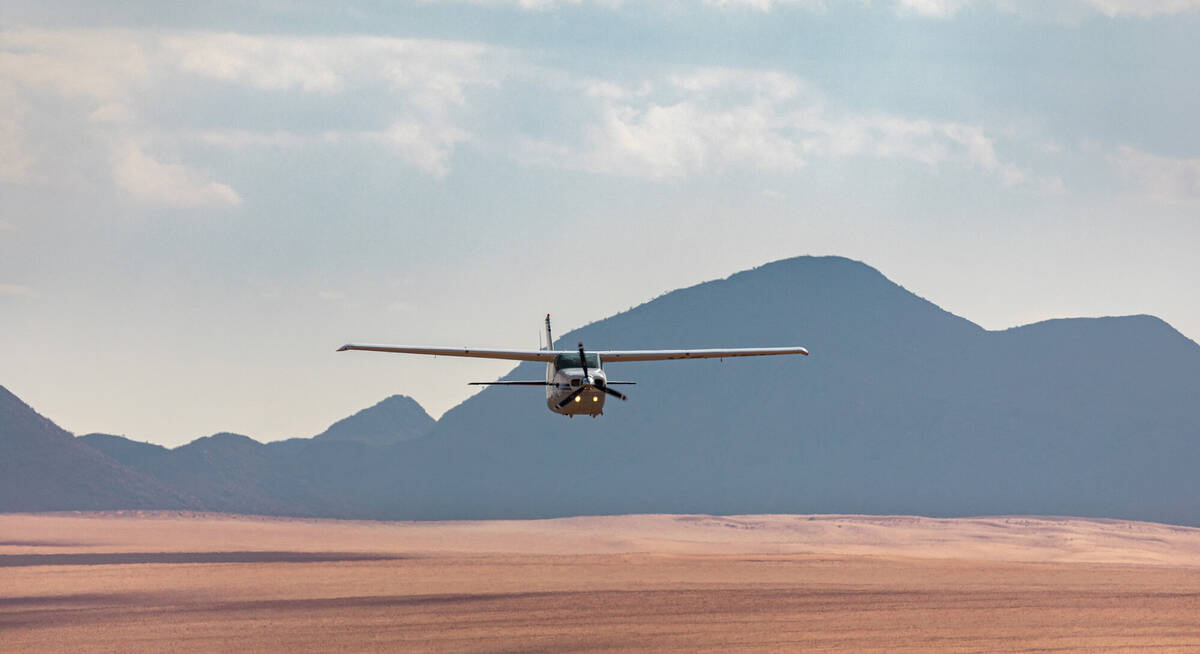
Monteiro's Hornbill Fly-in Safari
9 days • 5 locations
WINDHOEK AIRPORT TO WINDHOEK AIRPORT
Stay in four of Namibia’s most famous environments on this fly-in safari. It would be hard to pack more variety into a trip of the same length.
US$12,180 - US$14,720 per person
Most recent reviews of our safaris to NamibRand
Click the button below for 239 full & unedited reviews from our travellers to the NamibRand.
Arrived 9 Apr 2025, 11 nights
"My big birthday trip 2025"
Overall rating: Excellent
Arrived 3 Apr 2025, 17 nights
"My Apr 2025 trip"
Overall rating: Excellent
Arrived 27 Feb 2025, 9 nights
"My Feb 2025 trip"
Overall rating: Excellent
Arrived 22 Dec 2024, 14 nights
"Namib Desert, Damaraland, Etosha self-drive"
Overall rating: Excellent
Arrived 6 Sep 2024, 24 nights
"My Sep 2024 trip"
Overall rating: Excellent
Arrived 15 Aug 2024, 14 nights
"My Aug 2024 trip"
Overall rating: Excellent
Arrived 21 Jul 2024, 25 nights
"My Jul 2024 trip"
Overall rating: Excellent
Arrived 21 Jun 2024, 33 nights
"Unforgettable July 2024 trip"
Overall rating: Excellent
Arrived 13 Jun 2024, 11 nights
"My Jun 2024 trip"
Overall rating: Excellent
Arrived 8 Jun 2024, 20 nights
"My Jun 2024 trip"
Overall rating: Excellent
Where to stay in the NamibRand Reserve
Our suggestions for safari camps in the NamibRand Nature Reserve
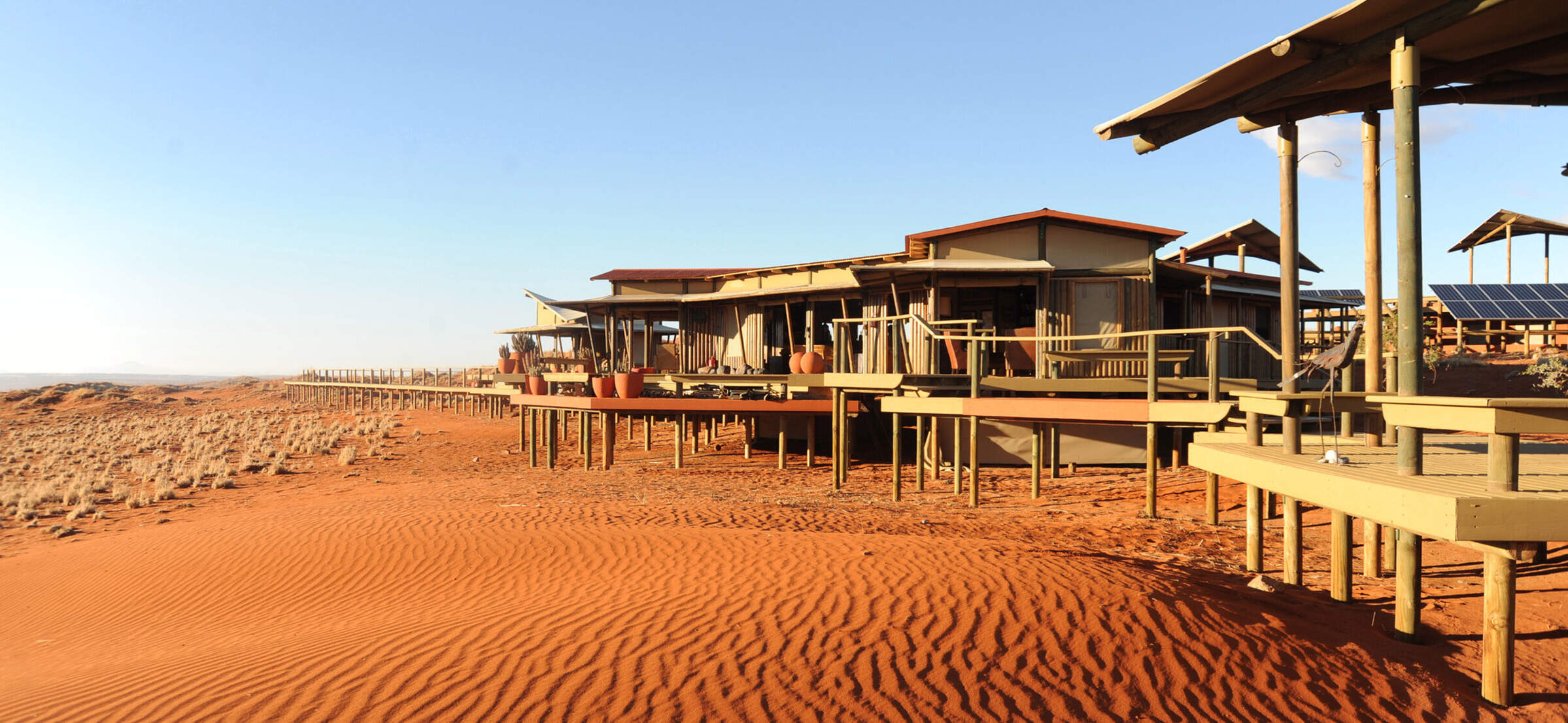
Wolwedans Desert Lodge
Wolwedans Desert Lodge is a beautiful camp in a stunning setting on the NamibRand Reserve. Stay here for a luxurious escape into the wilderness.
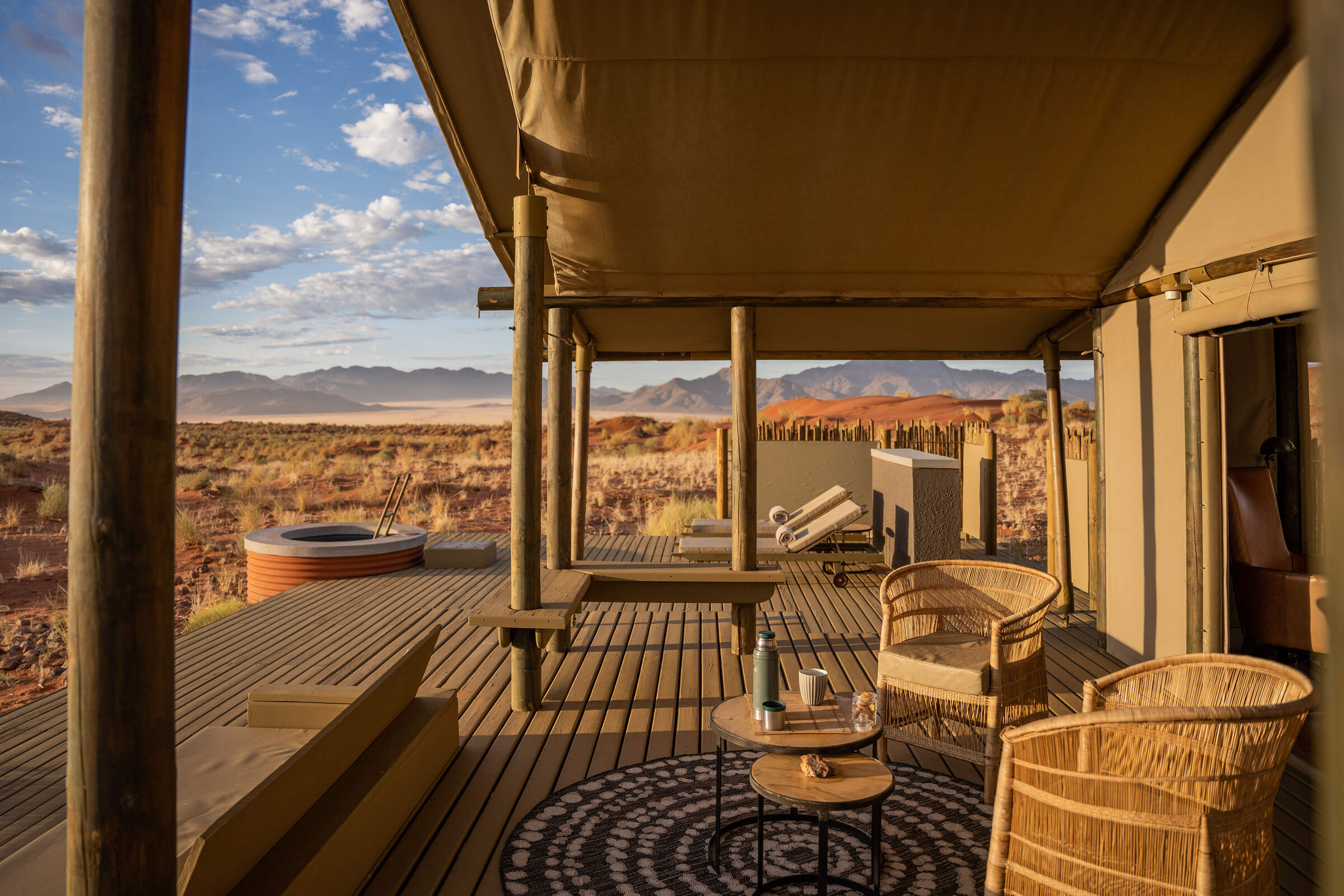
Wolwedans Dune Camp
Small and intimate with excellent service and great guiding, Wolwedans Dune Camp is a luxurious escape in a beautiful location.
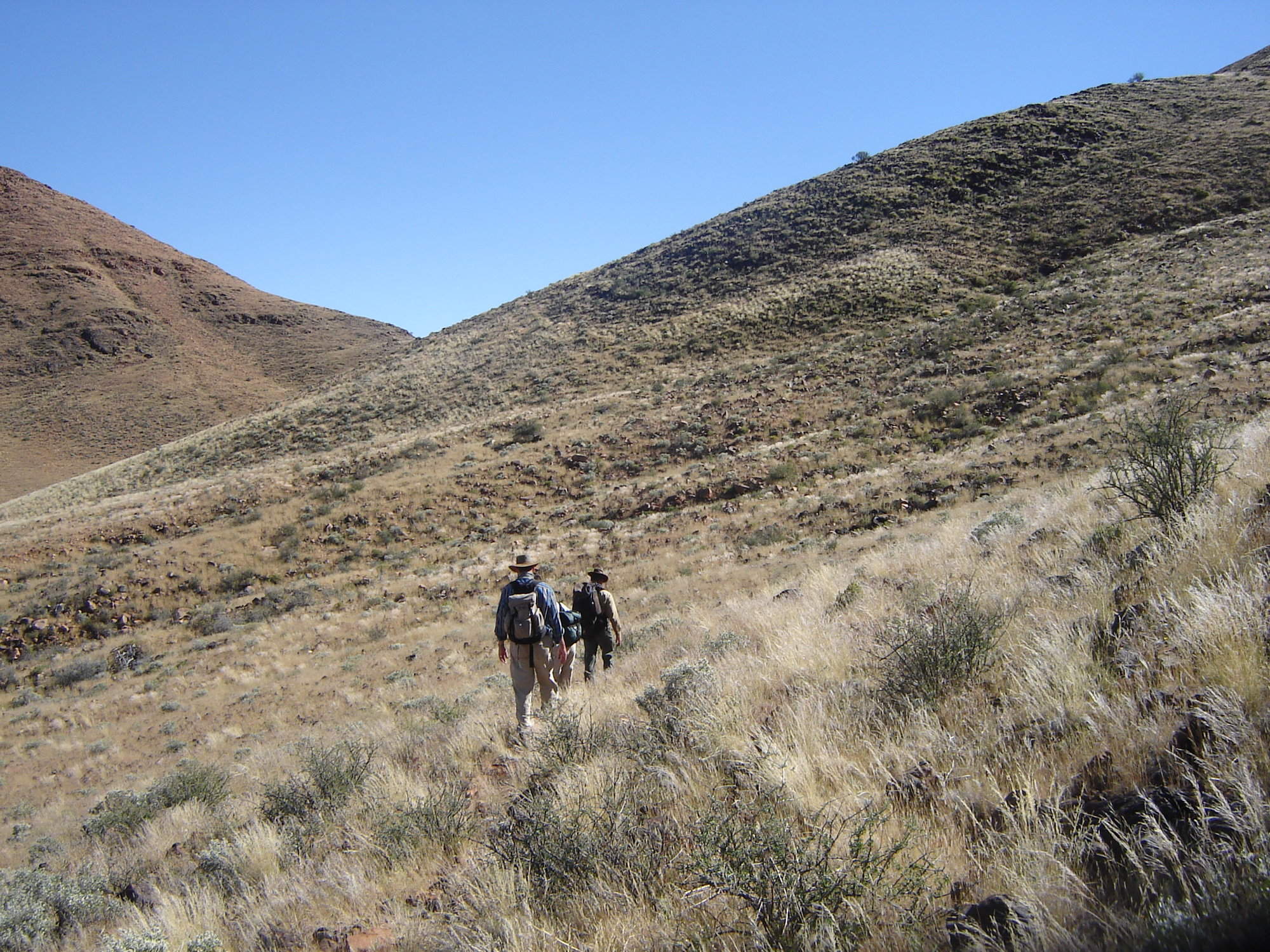
Tok Tokkie Trails
Escape the car and explore the spectacular Namib Desert on foot with an expert guide from Tok Tokkie Trails.
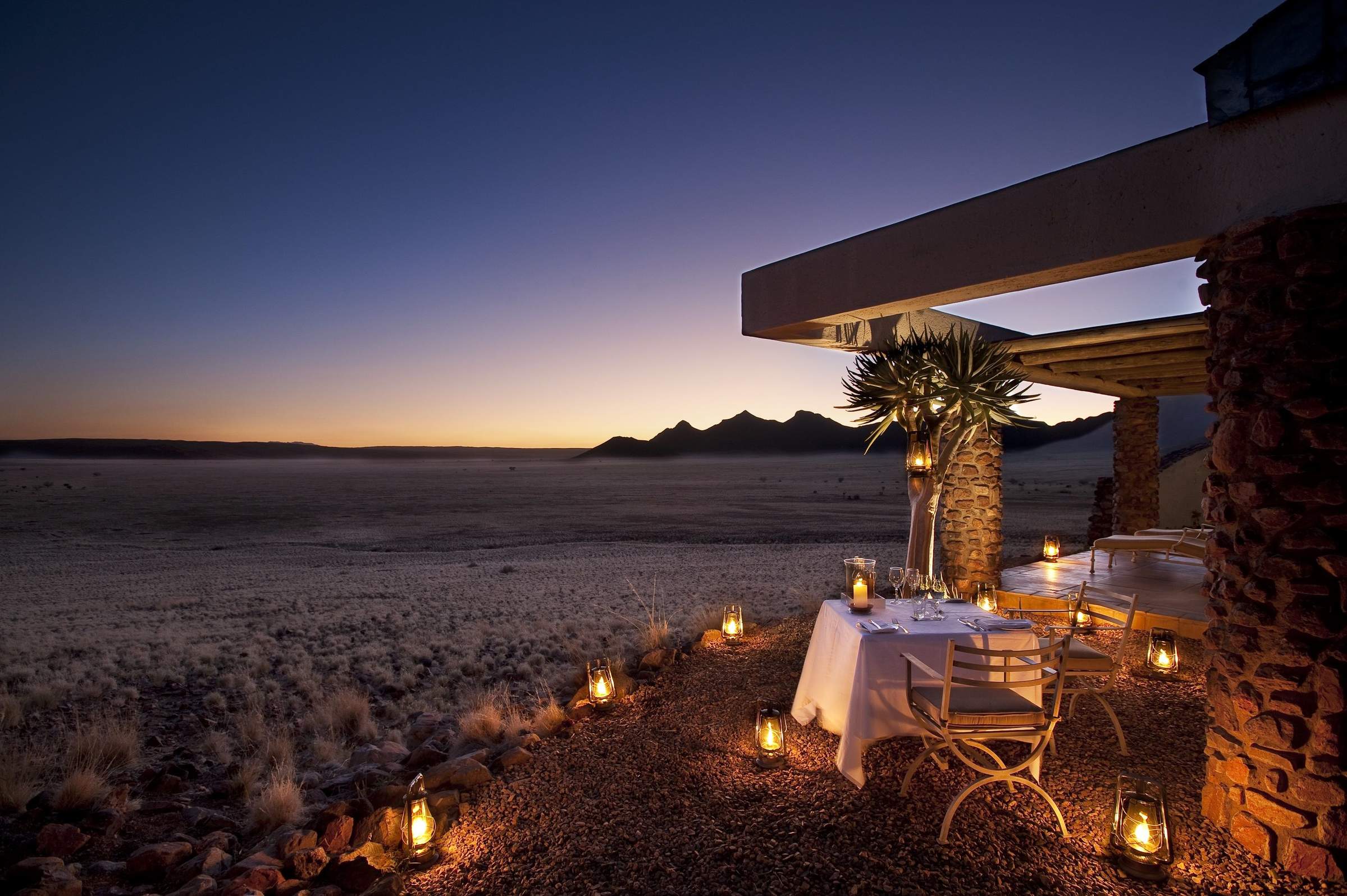
Sossusvlei Desert Lodge
Sossusvlei Desert Lodge is located on the NamibRand Reserve and offers a range of activities as well as high levels of comfort and service.
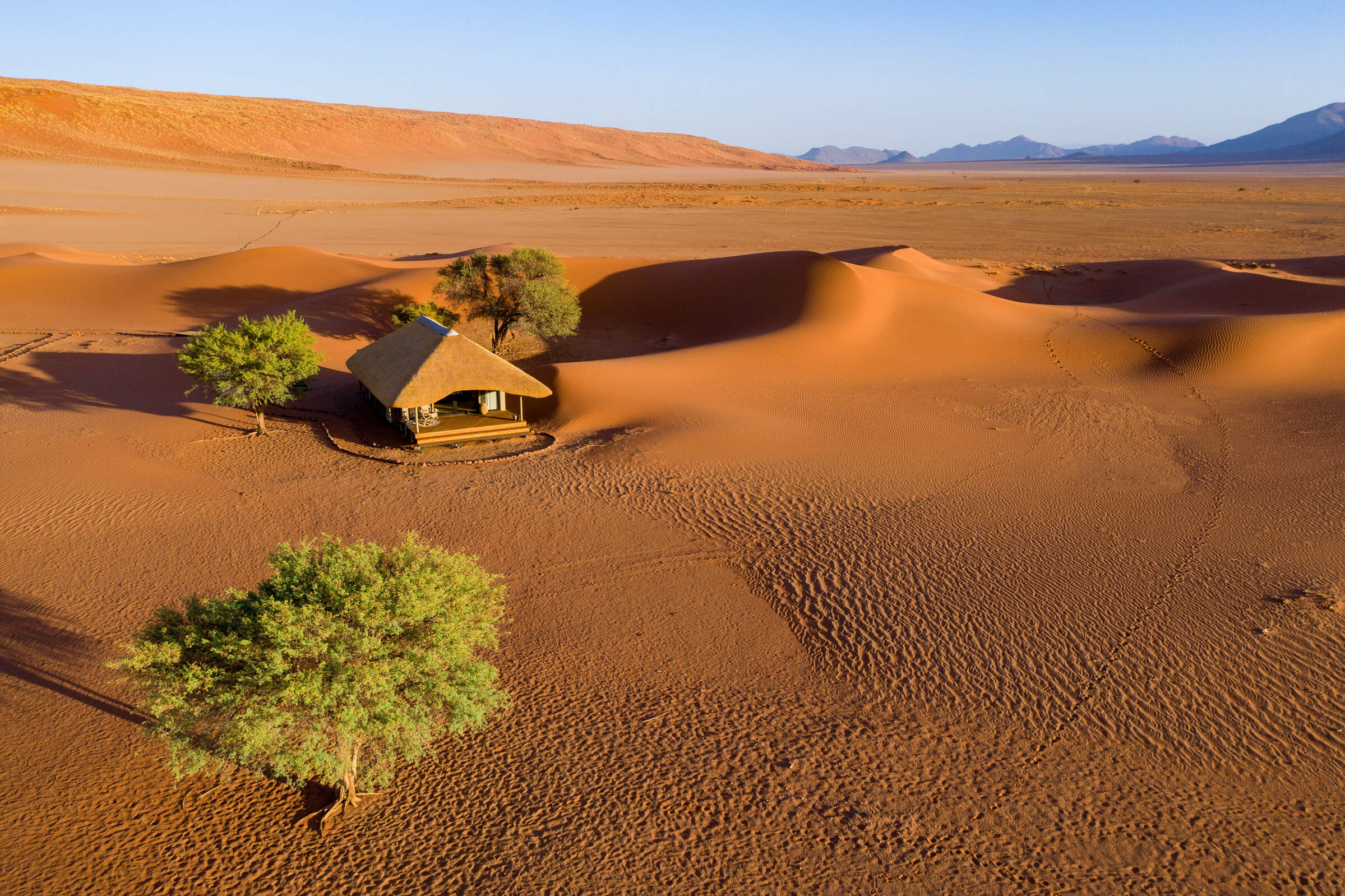
Kwessi Dunes
Kwessi Dune Lodge is a new property in the NamibRand Nature reserve promising to offer a luxurious stay in the wonderfully remote NamibRand Reserve.
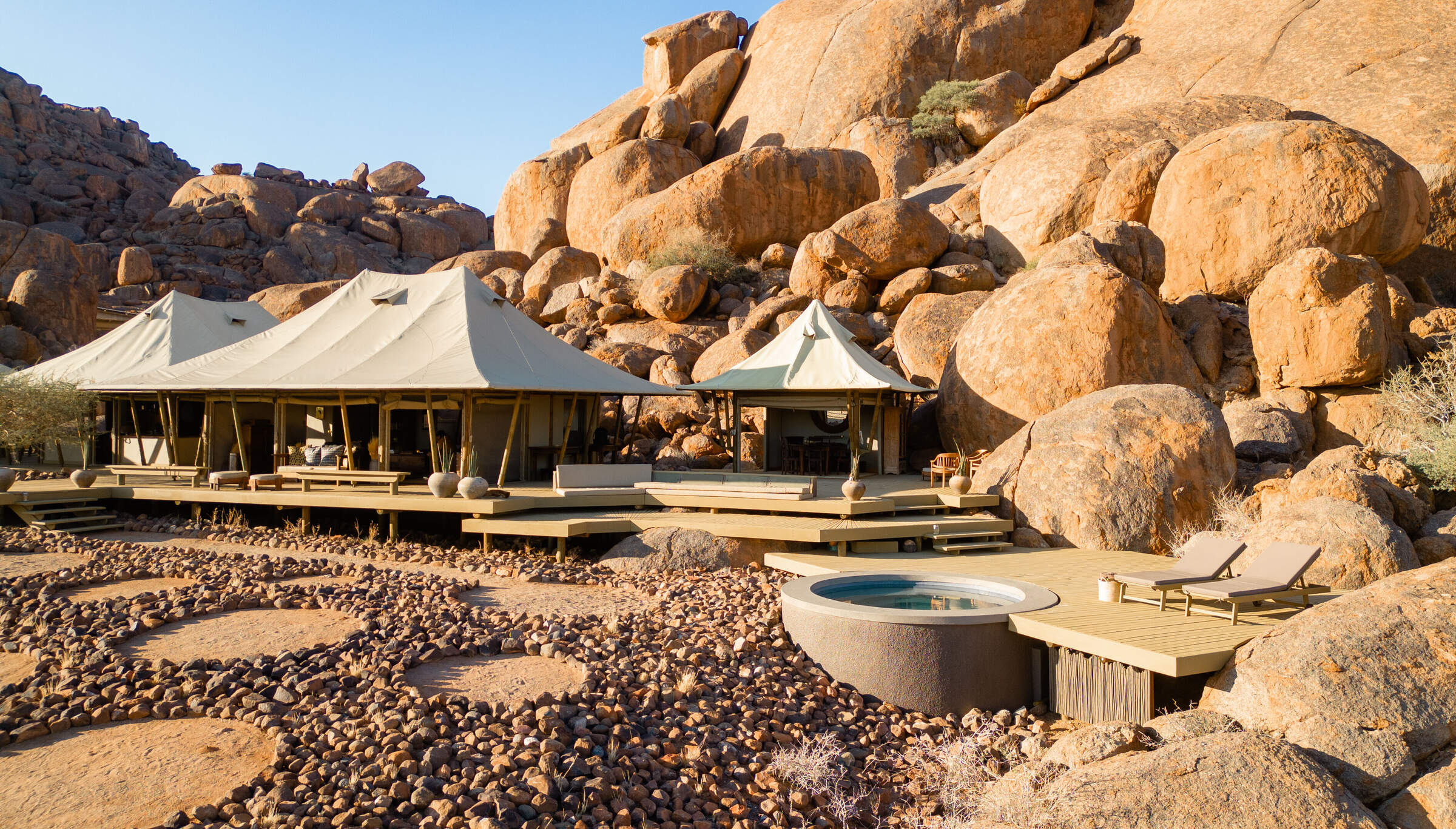
Wolwedans Boulders
Hidden away in a remote corner of the NamibRand enjoy good food and attentive service at the exclusive Wolwedans Boulders Camp.
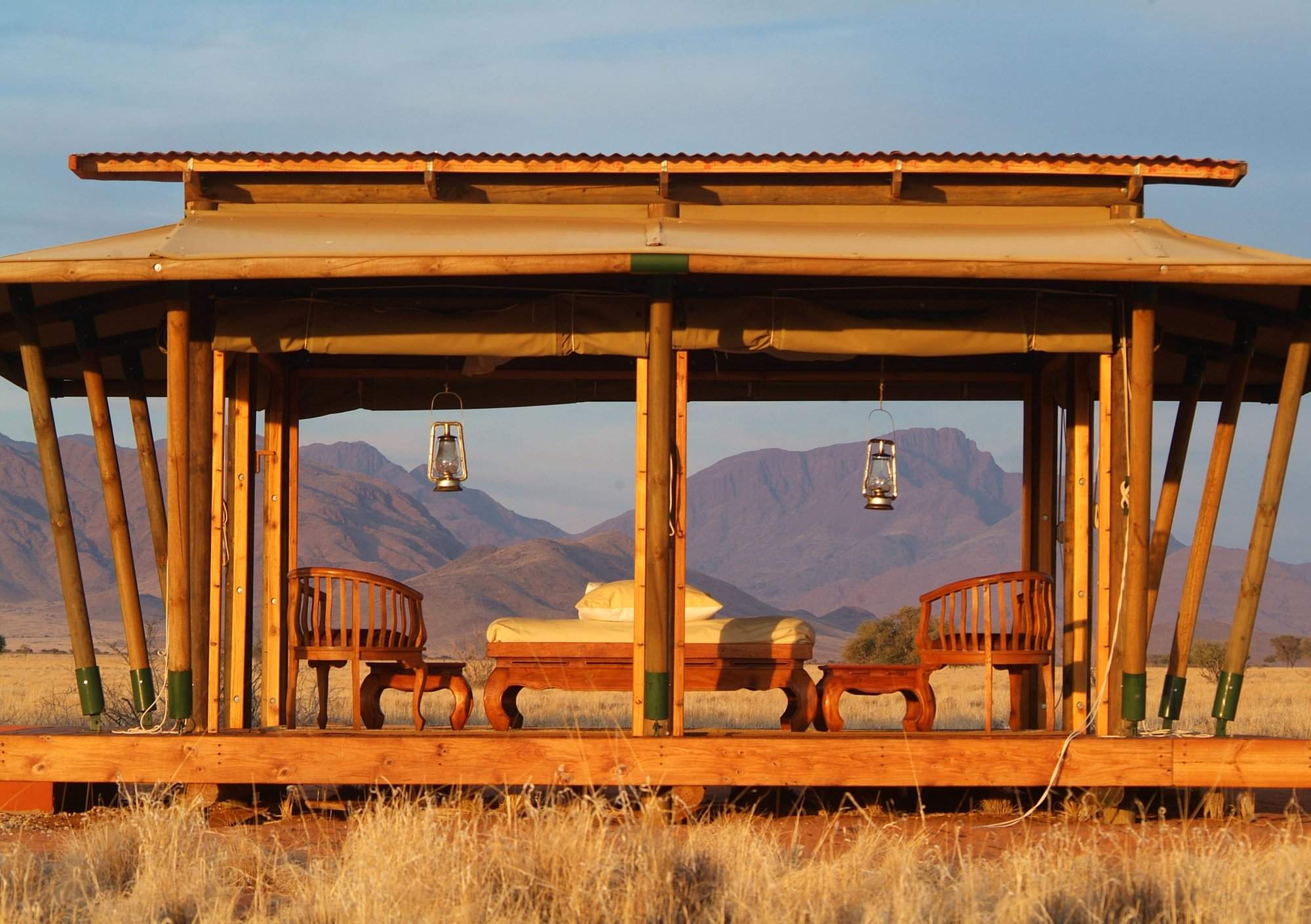
Wolwedans Plains Camp
With just three bedrooms, private chef and private guide, Wolwedans Plains Camp offers for peace and seclusion in a stunning setting.
Our travellers’ wildlife sightings in NamibRand
This is their success for sightings in NamibRand Nature Reserve. Click on a species for more detail. How we work this out.

98% success

91% success

26% success

19% success

5% success

3% success

3% success

3% success

0% success

0% success

0% success
When to go to NamibRand Nature Reserve
Our month by month guide: What it's like to visit NamibRand in Namibia
Jan
Feb
Mar
Apr
May
Jun
Jul
Aug
Sep
Oct
Nov
Dec
Namibia in January
January is at the heart of Namibia’s rainy season. However, as you’d expect from a country dominated by desert and semi-desert environments, the rains are often (but not always) weak and usually quite localised. Some days will be clear, the strong sun raising temperatures to around 30ºC/86ºF; on others humidity and clouds build, sometimes culminating in spectacular thunderstorms. In extreme cases, these generate flash-floods which race down the beds of ephemeral rivers.
Across the country, the greening landscape makes a refreshing change, especially in desert areas. Many birds are in full breeding plumage and migrant species are here in force. In the north, where the rains are more reliable, the abundant water and food allows wildlife to disperse, making it trickier to spot.
- Variable weather: clear, hot & dry, or cloudy & humid with some rain
- Occasional, highly localised thunderstorms
- Many animals with young; birdlife at its most spectacular
- Wildlife dispersed & harder to see, especially in Etosha & the Caprivi
- Very few tourists (apart from the New Year) so rates mostly low
Our view
This is not a great time to visit
Weather in January
Namibia in February
February is the wettest month, but as Namibia is dominated by deserts, the rains are often weak and patchy. The variation in weather across Namibia is significant, too; the central highlands and Caprivi can see some heavy rain. More typically, some February days are clear with a hot, strong sun; others are cooler as cloudy skies build and, sometimes, culminate in short, spectacular thunderstorms. Occasionally these generate flash-floods, bringing ephemeral rivers to life and making travel more challenging.
Across the country, the landscape feels green and alive; insects and smaller animals are more easily seen, and many birds and animals are raising their young. However, small pools in the bush and thicker vegetation can make it hard to spot the wildlife.
- Variable weather: clear, hot & dry or cloudy & humid with some rain
- Occasional localised thunderstorms meander over the landscape
- The bush feels alive; birdlife is at its most spectacular
- Wildlife in Etosha & Caprivi is dispersed & harder to see
- Few tourists, so rates usually at their lowest
Our view
This is not a great time to visit
Weather in February
Namibia in March
March usually sees Namibia’s main rains tailing off, although actual precipitation varies hugely across the country and can be unpredictable from day to day. Many days will be clear, with a strong sun driving temperatures up. On others, clouds will build, and the late afternoon may see a short, spectacular thunderstorm. Such deluges reduce in both frequency and volume as the month progresses.
Across the country, landscapes are often vivid: a “green and pleasant land”. Many birds and animals are finishing raising their young, so smaller animals and insects are in evidence. In the north, where rains are generally heavier, pools in the bush and thicker vegetation can make it difficult to spot larger animals.
- Variable weather: clear, hot & dry or cloudy & humid with some rain
- Afternoon thunderstorms less common as March progresses
- Animals looking sleek and well-fed, after 3–4 months of plenty
- Wildlife in Etosha & Caprivi is dispersed & harder to see
- Few tourists visit during March, so rates often low
Our view
A good time to visit, with pros & cons
Weather in March
Namibia in April
Typically, April is dominated by dry weather; there’s an ever-decreasing chance of rain. Temperatures are now below their peak and continue to fall. Even so, days remain pleasant and warm, but there might be a slight chill in the air at night. The rains usually leave many parts of the country verdant and green, so animals are in fantastic condition – often with fast-growing young in attendance.
With the dust washed out of the atmosphere, photographers make the most of clear air, spectacular landscapes and healthy animals. Stargazers will have clearer night skies as the month progresses. In the game parks of Northern Namibia, water and food remain in plentiful supply, so finding big game can prove trickier than later in the year.
- Becoming drier &, especially at night, also cooler
- Few visitors, except around Easter, so rates remain low
- Wildlife in Etosha & Caprivi remains relatively hard to see
- Migrant birds have started to leave
- Fresh, clean air and often green, verdant landscapes
Our view
A good time to visit, with pros & cons
Weather in April
Namibia in May
By May, Namibia is usually drying out fast as the rains have ended. If they’ve been good, then the land remains green, but wildlife starts to congregate at more permanent water sources. Over much of the country the air quality and clarity can be amazing, making this an ideal month for photography.
Typical days are warm, with crisp, clear mornings and clear blue skies. Evenings are usually cool, and temperatures may dip below 10ºC (50ºF) overnight. Many lodges still charge “low season” prices, although with Namibia’s increasing popularity in recent years, some have started to introduce higher “shoulder season” rates.
May’s good-value rates, increasingly good wildlife sightings, beautiful landscapes and crystal-clear air combine to make this one of our favourite months in Namibia.
- Lovely weather: dry, warm days & cool nights
- The country is drying out although many landscapes remain green
- Fantastic air clarity – ideal for keen photographers
- Visitor numbers are often still low, mirrored by lodge rates
- Wildlife is starting to congregate more around remaining water
Our view
A very good time to visit
Weather in May
Namibia in June
Namibia is dry again. Skies are blue and usually largely cloudless. Days are lovely: warm and dry; nights are cold, sometimes below freezing in the desert. Most swimming pools in Namibia are always outdoors, making them too cold for all except the very dedicated.
Take a warm hat and gloves for game drives, where dawn and dusk will feel particularly chilly. In the north, especially Etosha, wildlife viewing is now into its dry-season pattern, focusing around the waterholes – though the park is still not busy.
Photographers come for superb air clarity, with minimal dust or smoke in the air. Historically, June rates have been low. However, with Namibia’s increasing popularity many lodges now count it amongst their “high-season” months, and request higher prices.
- Clear, bright days with blue skies; cold nights, mornings & evenings
- Great air quality, especially welcome for photographers
- “Shoulder season” for some lodges: lodge rates moderate
- Wildlife gravitates to waterholes, making game-viewing productive
- Some greenery in the landscape, depending on the last rains
Our view
A very good time to visit
Weather in June
Namibia in July
Reliably warm daytime temperatures (upwards of 20ºC/70ºF) and good wildlife sightings make this a popular month to visit Namibia. Rain would be very unusual indeed and clear skies make for great photographs. Once the sun sets, though, temperatures cool rapidly bringing cold nights that may dip below freezing in the desert. Be prepared: dress in layers and expect early-morning and late-afternoon drives, and anywhere coastal, to be cold.
As the land dries and vegetation shrivels, game congregates beside drinking water: Etosha’s waterholes are busy with animals. Across the country, lodges charge “high season” rates; many are fully booked a year or more in advance, especially during European school holidays (from the latter half of July to late August).
- Dry days, warm in the sun, with crisp, cold nights
- Cloudless skies: July is usually superb for stargazing
- The beginning of European school holidays so more families travelling
- Peak season: so high rates and many lodges fully booked far in advance
- A fantastic time of year for wildlife watching, particularly in Etosha
Our view
A very good time to visit
Weather in July
Namibia in August
August is the height of Namibia’s “winter”. Expect cloudless skies and plenty of warm sun in the day, but nights down to freezing in the desert. Dress in layers and bring warm clothes (including hats and gloves) for chilly starts and evenings. Only the hardiest even contemplate using outdoor pools.
It’s 3–4 months since any rain, so the land is dust-dry and much vegetation is golden brown. Many landscapes appear sparse and harsh. Wildlife congregates around available water sources, helping to guarantee good animal sightings.
Namibia is never really “busy” by the standards of Europe or the USA, but August is the most popular time to visit, especially for families. Book early (over a year in advance) if you want to stay at the best lodges.
- Dry days, warm in the sun; cold mornings, evenings & nights
- Cloudless skies in the day; spectacular stars at night
- Busy by Namibian standards: family rooms in particular demand
- Peak season: so high rates and many lodges fully booked far in advance
- A fantastic time of year for wildlife watching, particularly in Etosha
Our view
Fantastic: the very best time to visit
Weather in August
Namibia in September
September is a month of blue, cloudless skies and fantastic wildlife viewing. Rain is almost unheard of. As the month progresses, the days and nights get warmer. In some areas, daily maximums hit around the low 30s Celsius, although low humidity ensures this feels comfortable. The contrast makes the nights seem very cold. The air is becoming dustier, occasionally augmented by smoke from fires – so becoming hazy for photographic purists.
In the national parks, animals congregate around remaining water sources – making September one of the best months for game viewing. Hence it’s one of Namibia’s most popular months for visitors: a “high season” month that is often the time of choice for safari aficionados.
- One of the best months for wildlife viewing
- Warm days & cold nights, with temperatures rising during the month
- Many plants have faded from green to golden brown
- Air can be hazy – with dust & sometimes smoke
- High season rates; many lodges & camps are full 9 months in advance.
Our view
Fantastic: the very best time to visit
Weather in September
Namibia in October
Namibia is usually at its hottest and driest in October. Temperatures build as the month progresses; towards the end, daily highs may exceed 40ºC/100ºF, though with humidity close to zero, even this rarely feels oppressive.
In exceptional years, isolated rain showers may fall in late October. More usually, the end of the dry season sees wildlife watching at its best, particularly in Etosha. The place feels like a desert as spectacular herds of thirsty animals gather around the available water. October is popular amongst wildlife enthusiasts and commands peak-season prices, even if dust and smoke may make the air hazy, challenging photographers. Visitor numbers can fade towards the end of the month, allowing a window for last-minute bookings.
- Probably the most spectacular month for wildlife-viewing in Etosha
- Hot and dry: much of the country feels like a desert
- The air can be hazy with dust & smoke
- It’s peak time to visit, so expect high season rates
- Lodges & camps are full, especially early in October
Our view
A very good time to visit
Weather in October
Namibia in November
November is always a bit unpredictable: sometimes dry and hot; sometimes cloudier and cooler. Typically, mornings are hot and cloudless and clouds appear in the afternoon. Humidity builds and eventually breaks, resulting in spectacular thunderstorms that bring convection rainfall in late afternoons. Such storms are typically sparsely distributed and highly local – being completely absent from desert areas, for example. Places that do get good rain will flush green, with a tangible feeling of new life softening the landscapes. Many mammals give birth to their young.
Once any rains come, wildlife dissipates in search of food, and game viewing in Etosha becomes harder. Conversely, this is a great time for birdwatchers, with migrant species in breeding plumage.
- A very interesting, variable month, depending on the rains
- With rains come an amazing explosion of both vegetation & new life
- Wildlife viewing better in Damaraland than Etosha if it has rained
- Shoulder season: mid-range rates offer great value
- Away from the Namib, showers are more likely later in the month
Our view
A good time to visit, with pros & cons
Weather in November
Namibia in December
December is the first “proper” month of Namibia’s rainy season, and one of its hottest. Clear mornings give way to building clouds and, with luck, the occasional short, spectacular thunderstorm: refreshing and cleansing. These are often highly localised and generally warmly welcomed: most Namibians love rain!
Rains clear the air of dust. Even relatively short showers enable plant life to erupt, carpeting this thirstland in green and providing food for the young animals which abound. Animals disperse widely, which can make game viewing challenging. Many birds are breeding and so sporting their most colourful plumage.
Christmas and the New Year fall within local “summer holidays” – so places to stay can be surprisingly busy, especially in and around coastal towns, where temperatures are cooler.
- Hot and humid; sometimes refreshed by cooling showers
- Landscapes flushed green if/where there has been rain
- A tangible life and energy amidst this often green & pleasant land
- Very photogenic: blooming deserts amidst crystal-clear air
- Best time for birdwatchers; larger animals harder to spot
Our view
This is not a great time to visit
Weather in December
NamibRand Nature Reserve: In detail
NamibRand Nature Reserve
Around 400km south-west of Windhoek and south of Sesriem, the NamibRand Nature Reserve protects a beautiful area of desert.
Low dune fields cut into the desert plains compliment mountains that are visible in the distance. At sunrise, the contrast of the ochre sand, yellow grasses and long dark shadows make for spectacular photography. It’s a magical, captivating place.
Covering an area over 2,150km2, an area nearly the size of Luxembourg, the NamibRand Nature Reserve is one of Southern Africa’s largest private nature reserves. Established in 1984, the vision of J A (Albi) Bruckner, former livestock farms were amalgamated in order to protect this unique environment and its rich biodiversity.
The reserve is defined by the striking Nubib Mountains to the east and shares 100km of its border to the west with the main Namib-Naukluft National Park. Within these borders, there are a wide variety of desert landscapes and environments, from huge red sand dunes to vegetated inter-dune valleys and sand and gravel plains interrupted by mountain ranges and inselbergs. It’s a spectacular area of desert.
The remoteness and solitude of the area are best enjoyed on a guided walk or nature drive or by gazing out at the stunning surroundings from the comfort of your lodge. As only the second place in the world to be designated as a Gold Tier International Dark Sky Reserve, a glance skywards at night should not be missed.
History of the NamibRand
Game was the only option, and this survived well on the farm Gorrasis, owned by J.A (Albi) Brückner (a businessman, rather than a farmer, who’d bought the farm for its landscapes). In 1988 Brückner bought out two neighbouring farms, Die Duine and Stellarine, and gradually the reserve was broadened from that base. Now 17 former livestock farms have been combined to form the reserve with financial input from various shareholders, and an ongoing commitment from the landowners involved to set aside the land for present and future conservation.
The NamibRand’s Flora and Fauna
Mammals of the NamibRand
The vast reserve is home to oryx (often called 'gemsbok' in Namibia), springbok, kudu, Hartmann's and Burchell's zebra, giraffe, klipspringer, steenbok and hartebeest. Most numerous are the gemsbok and springbok, a recent game census estimated their numbers to be around 3,200 and 12,400, respectively. Red hartebeest are found in the reserve, too, as are blesbok, which have been introduced from South Africa. Visitors may also be lucky enough to catch sight of leopard, spotted and brown hyena, black-backed jackal, bat-eared and Cape fox, caracal or one of the cheetah that have been introduced here as part of a conservation programme.
On one June visit, we were stunned when on a cool, very overcast afternoon we spotted no fewer than ten aardwolves and eight black-backed jackals on our afternoon nature drive. Even our guide was excited about these sightings, though he was quick to point out that we were luckier than most.
Another species of particular interest is the Grant’s golden mole, which is only found on the west fringes of southern Africa. This blind, nocturnal, mostly solitary animal “swims” through sand during the day to escape the heat of the desert. At night the animal comes to the surface, scampering across the dunes in search of prey. If you are lucky enough to glimpse this rare animal at night, you may witness it diving back into the sand to grab invertebrates that it has sensed by detecting their vibrations.
Birds of the NamibRand
For the ornithologist, over 150 species of birds have been identified in the reserve. This includes the massive but endangered lappet-faced vulture with its 3m wingspan, Ludwig’s bustard and Namibia’s only true endemic bird, the dune lark. Often seen skipping up and down the sand dunes, this bird persists exclusively in the driest part of the country and survives, with limited moisture, predominantly on seeds and insects.
Other species of interest in the NamibRand
As well as the impressive larger birds and mammals within the reserve there are many fascinating smaller creatures, which could be missed as they scuttle beneath your feet. Many have unique adaptations, which have evolved in order for them to thrive in the dry, desert environment. For example the dancing white lady spider that lives in a 30–40cm long silk-lined burrow and uses a “dancing” action to drum on the sand to communicate with other spiders. Or look out for the wheel spider, which has developed a unique escape mechanism of “cartwheeling” down the sand dunes to evade predators. The well-known “sidewinding” adder is also found in the reserve, one of the few snakes in the world with eyes on the top of its head; you may find it using its unique method of locomotion to traverse the reserve’s sand dunes.
Activities in the NamibRand area
Take to a 4x4 vehicle with a guide and be driven around this undisturbed and sometimes alien landscape. Choose a time and distance to suit you from a 1–2-hour sundowner drive to a full-day outing including a peaceful, remote picnic. This is a great way to get a sense of the scale of the reserve and to experience its varied landscape.
Walking trails in the NamibRand
Whether you would like a guided nature walk or you would prefer to find your own way on a marked walking trail, both are possible within the reserve. For the more adventurous traveller TokTokkie Trails offers a fully guided trip of 2 nights and 3 days in the south-east of the reserve. The trail has been designed at a leisurely pace and hikers retire to a two-course meal, hot bucket showers and a camp bed under the starry Namibian skies at two camps along the route.
Other activities in the NamibRand
Other activities on the NamibRand Nature Reserve depend on where you are staying. To experience the reserve from the air is possible in a hot-air balloon or a scenic flight; back on terra firma, you can explore at speed on a quadbike trail through the dunes.
Stargazing in the NamibRand
Because of its exceptionally dark night skies allowing for outstanding astronomy, the NamibRand Nature Reserve was designated a Gold Tier International Dark Sky Reserve in 2012 by the International Dark Sky Association (IDA). It was only the second place in the world to receive the Gold or “darkest” accolade, and the first in Africa.
The NamibRand has worked hard to adapt all artificial lighting used by properties within the reserve to meet the IDA standard, to maintain not only an unspoiled night sky but also the environment in its most natural form. A stay at Sossusvlei Desert Lodge, with its sophisticated observatory, Meade LX200R 12 inch telescope and resident astronomer, will give you the best insight, in the area, into the wonders of the night sky.
Map of NamibRand Nature Reserve
Choices for where to stay in NamibRand Nature Reserve
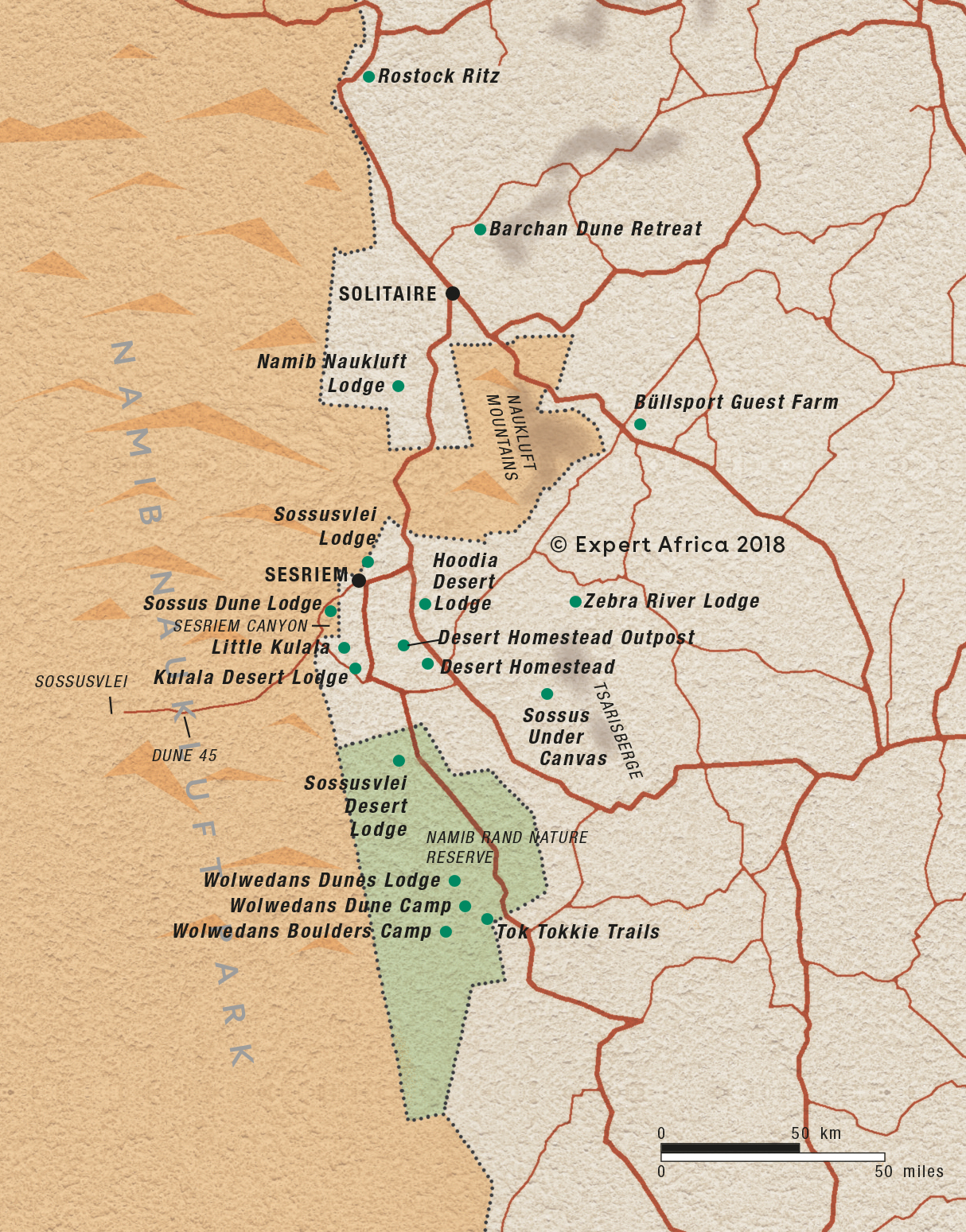
NamibRand Nature Reserve: Safaris

Brown Hyena Self-drive
14 days • 8 locations
WINDHOEK AIRPORT TO WINDHOEK AIRPORT
The perfect trip for those who want to mix the adventure and freedom of a self-drive with some of our favourite luxury camps in Namibia and a great mix of activities.
US$9,260 - US$10,210 per person

Chongololo Self-drive Safari
21 days • 11 locations
WINDHOEK AIRPORT TO WINDHOEK AIRPORT
This self-drive safari focuses on the best walking experiences in Namibia. Get your boots ready for the apricot dunes of the Namib Desert and the ancient hills of Damaraland.
US$9,260 - US$10,220 per person

Rock Agama Self-drive Safari
9 days • 6 locations
WINDHOEK AIRPORT TO WINDHOEK AIRPORT
Big on experience and light on time, this self-drive trip packs in Namibia’s highlights while staying in a selection of luxury camps and lodges for an unforgettable 10 days.
US$9,920 - US$14,770 per person

Goshawk Fly-in Safari
12 days • 6 locations
WINDHOEK AIRPORT TO WINDHOEK AIRPORT
Discover Namibia’s remarkable landscapes, fascinating wildlife and unique cultures on this luxury adventure flying between a selection of the very best camps and lodges in the country.
US$13,580 - US$20,350 per person

Monteiro's Hornbill Fly-in Safari
9 days • 5 locations
WINDHOEK AIRPORT TO WINDHOEK AIRPORT
Stay in four of Namibia’s most famous environments on this fly-in safari. It would be hard to pack more variety into a trip of the same length.
US$12,180 - US$14,720 per person
Lodges & safari camps in NamibRand
The focus of the tourism, in this area, is to financially support the conservation of this fragile and sensitive environment. With guest beds limited to 1 per 1,000 hectares and at a maximum of 20 beds per lodge, expect low density, low impact but high quality accommodation. Living up to what the word ‘Namib’ is thought to mean in the local language- a big empty space- there are just a few places to stay in the vast NamibRand Reserve:

Wolwedans Desert Lodge
Wolwedans Desert Lodge is a beautiful camp in a stunning setting on the NamibRand Reserve. Stay here for a luxurious escape into the wilderness.

Wolwedans Dune Camp
Small and intimate with excellent service and great guiding, Wolwedans Dune Camp is a luxurious escape in a beautiful location.

Tok Tokkie Trails
Escape the car and explore the spectacular Namib Desert on foot with an expert guide from Tok Tokkie Trails.

Sossusvlei Desert Lodge
Sossusvlei Desert Lodge is located on the NamibRand Reserve and offers a range of activities as well as high levels of comfort and service.

Kwessi Dunes
Kwessi Dune Lodge is a new property in the NamibRand Nature reserve promising to offer a luxurious stay in the wonderfully remote NamibRand Reserve.

Wolwedans Boulders
Hidden away in a remote corner of the NamibRand enjoy good food and attentive service at the exclusive Wolwedans Boulders Camp.

Wolwedans Plains Camp
With just three bedrooms, private chef and private guide, Wolwedans Plains Camp offers for peace and seclusion in a stunning setting.
Excursions from NamibRand Nature Reserve
Optional extra day-drips and excursions from within the NamibRand. Talk to us: these are usually best arranged before you go.
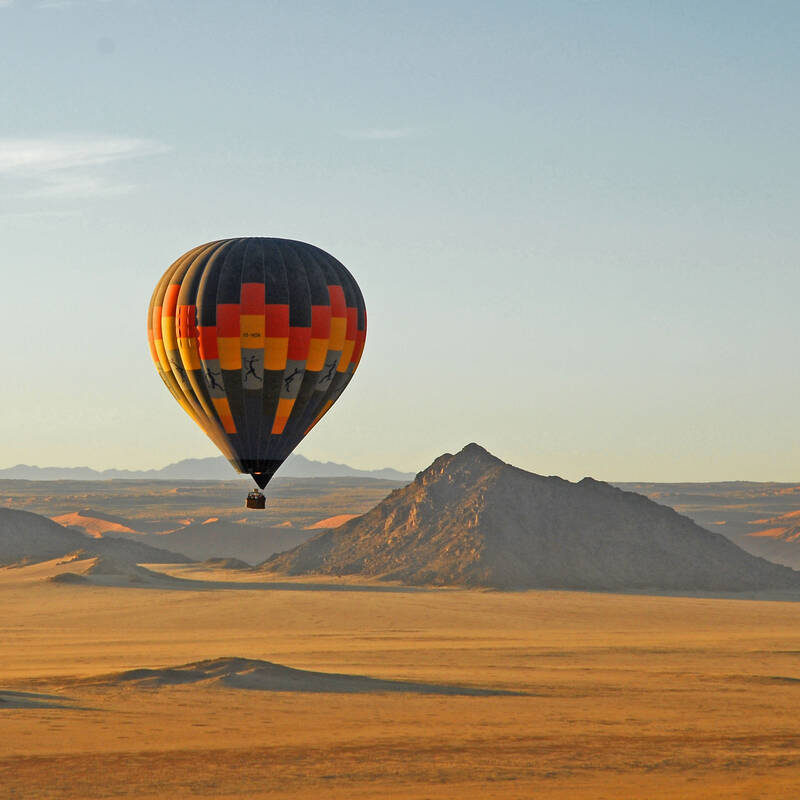
Ballooning in the Namib Desert
Half day, including breakfast
Ballooning over the world’s oldest desert is an experience you shouldn’t miss. Enjoy spectacular views as the sun rises over the dune-covered plains and rocky mountains of the Namib Desert. You may even spot the occasional oryx or black-backed jackal punctuating the landscape below.
More about Ballooning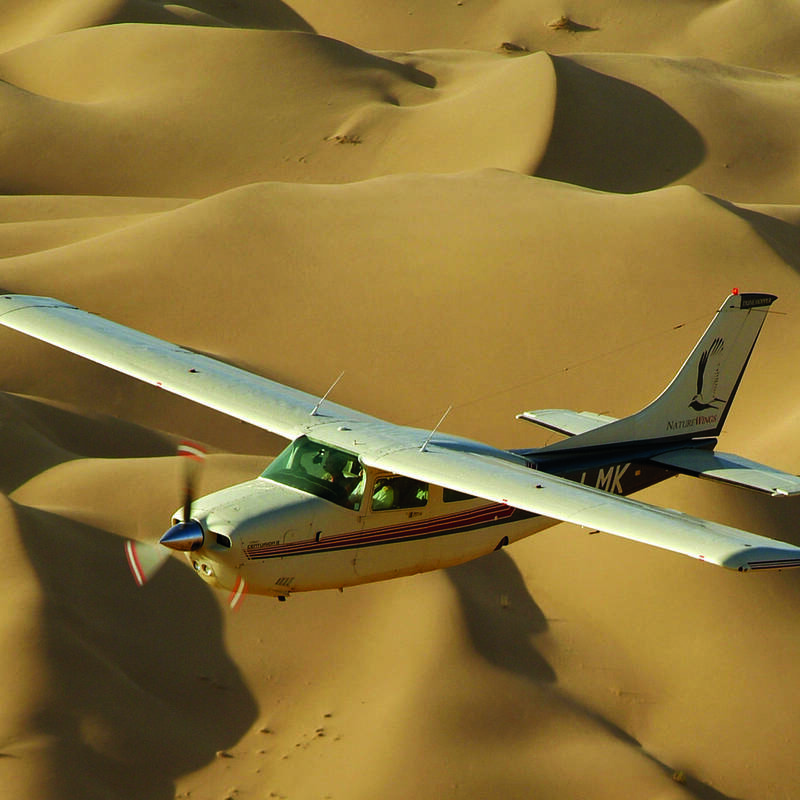
Scenic flights in Namibia
Variable, depending on the flight
Namibia is famed for its stark beauty and boundless desert vistas and there is no better way to soak these in than from the air. A scenic flight gives you a unique perspective on this stunning and varied country, and may even provide a bird’s-eye view of areas that are out of reach to those restricted to terra firma.
More about Scenic flights
Looking for inspiration on where to travel next?
Visit our trip chooser to explore your options and find inspiration for your perfect African adventure
Inspire me